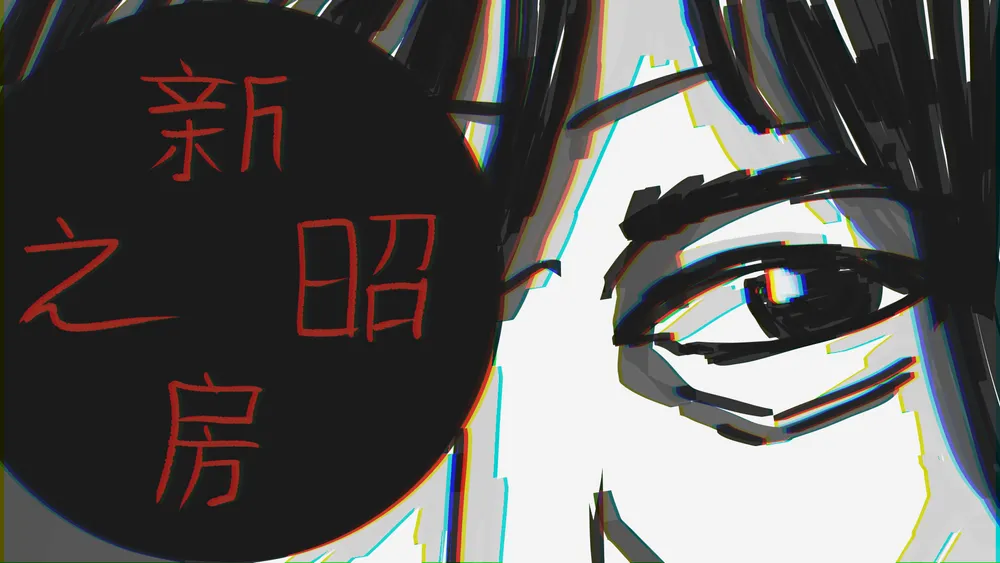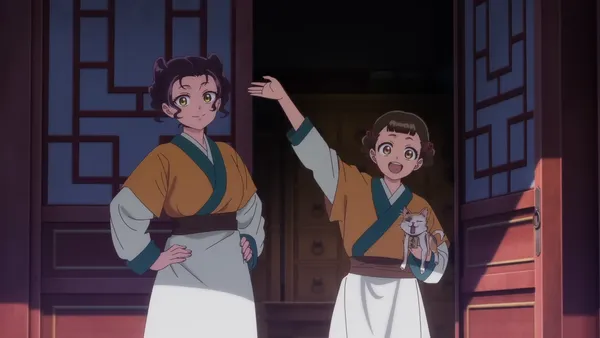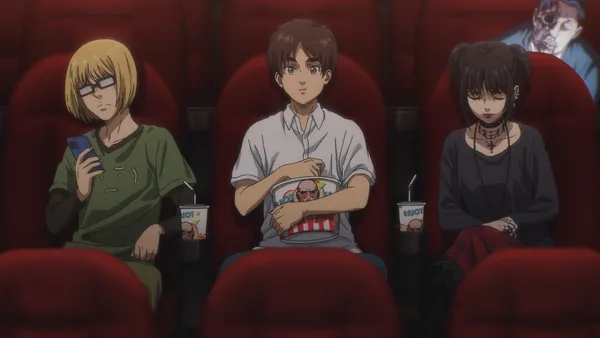What Does Akiyuki Shinbo Even Do?
A longstanding question that comes with watching and attempting to make sense of studio SHAFT works for those who have any semblance of interest in who exactly is making the anime that is on their screen is:
What does Akiyuki Shinbo do?
For nearly 20 years, the name “Shinbo” was a nigh ubiquitous monomer that served to only identify works of studio SHAFT, despite the fact that not only are most SHAFT works not representative of “the style of Akiyuki Shinbo” outside of his core directorial influence (take it from him, not me); but also because almost all of “his” works at SHAFT are more accurately described as collaborations between himself as the gardener of a flower field and the brilliance of his staff being shown off, as he tends to them and lets their colors bloom within the framework he both built and watches over.
Fortunately, the longstanding days of attributing SHAFT’s stylistic ideas solely to Shinbo are (mostly) over, instead replaced by the question of "did he do anything at all?" The answer to both is that it really depends on what series we’re talking about.
I will speak on all of the SHAFT series Shinbo was involved with and the responsibilities that I know he took on, or that I can at least make an educated guess about.
It’s important to note that credits are just a general way of telling you what someone did; they’re sometimes arbitrarily given and not consistent from one work to another, but they each generally have some sort of nuance attached. There will be a lot of comments on this throughout.
The Works
Tsukuyomi: Moon Phase (2004-2005)
- Chief Director (総監督): Akiyuki Shinbo
- Directing Assistant (監督補佐): Toshimasa Suzuki
- Visual Director (ビジュアルディレクター): Nobuyuki Takeuchi
This one is easy: Shinbo directed the show. For the most part. While Tsukuyomi was in production, Shinbo was also busy directing Magical Girl Lyrical Nanoha and Le Portrait de Petit Cossette at two different studios (Seven Arcs and Daume, respectively), so Shinbo ended up not being on-site at SHAFT very often, leading to Suzuki being there as the on-site director executing the orders in his place. With no series director beneath him, we know for a fact that Shinbo was heavily involved with the storyboarding process; he would have checked all of the storyboards himself and made the corrections necessary.
Shinbo’s storyboarding corrections can be felt throughout the series, especially in episodes where the gothic atmosphere ends up blowing up everything else (I mean this in a positive way). Hiroshi Kamiya also once mentioned that Shinbo wasn’t present for the casting auditions, and they met at the post-recording for episode 1. Albeit uncredited, the first episode was storyboarded by Shinbo, which he confirmed to be a glorious 308 total cuts; and the third version of the ending was also storyboarded by Shinbo himself.
As for what Takeuchi was doing: a lot of production design/setting design work. Shinbo asked SHAFT’s president, Mitsutoshi Kubota, if he knew anyone with strong setting design sensibilities, and Kubota recommended Takeuchi who had a desk at the studio since around 1994 when Tatsunoko Production was outsourcing The Legend of Snow White to SHAFT.
Pani Poni Dash! (2005)
- Director (監督): Akiyuki Shinbo
- Series Director (シリーズディレクター): Shin Oonuma
The first of Shinbo’s works that featured direction from someone else: the one and only Shin Oonuma, invited to SHAFT through him. Essentially, Shinbo took somewhat of a step back when it came to handling things on-site, and he wasn't as particular about making big storyboard revisions following Tsukuyomi.
Here is where we can first discuss one of the general main differences between roles as they’re used on these productions: when Shinbo is credited as “director” and someone else is credited as “series director.” Generally, that tends to mean that Shinbo was originally doing the directing work himself at pre-production and at some point (either in pre-production or in production) a series director was appointed to direct things on-site (especially during production), with Shinbo still having some overall supervision. When Shinbo is credited as “chief director” and someone else is credited as “director,” generally that means the same thing, except that the director has a lot more say and is there from the beginning (or close to the beginning) of pre-production.
In the case of Pani Poni Dash, I’m not well-inundated with the show’s production to comment on how that might’ve been handled for this specific series–but I’m going to take a solid guess and say it was probably something where Shinbo was already handling the pre-production side, and Oonuma was asked to handle the show part-way through.
Negima!? OVAs (2006)
- Chief Director (総監督): Akiyuki Shinbo
- Director (監督): Shin Oonuma
It was difficult getting the information here, so using the aforementioned logic, I will presume Shinbo and Oonuma were both involved with pre-production, and Oonuma directed as usual. Shinbo did, however, storyboard the "Spring" episode himself.
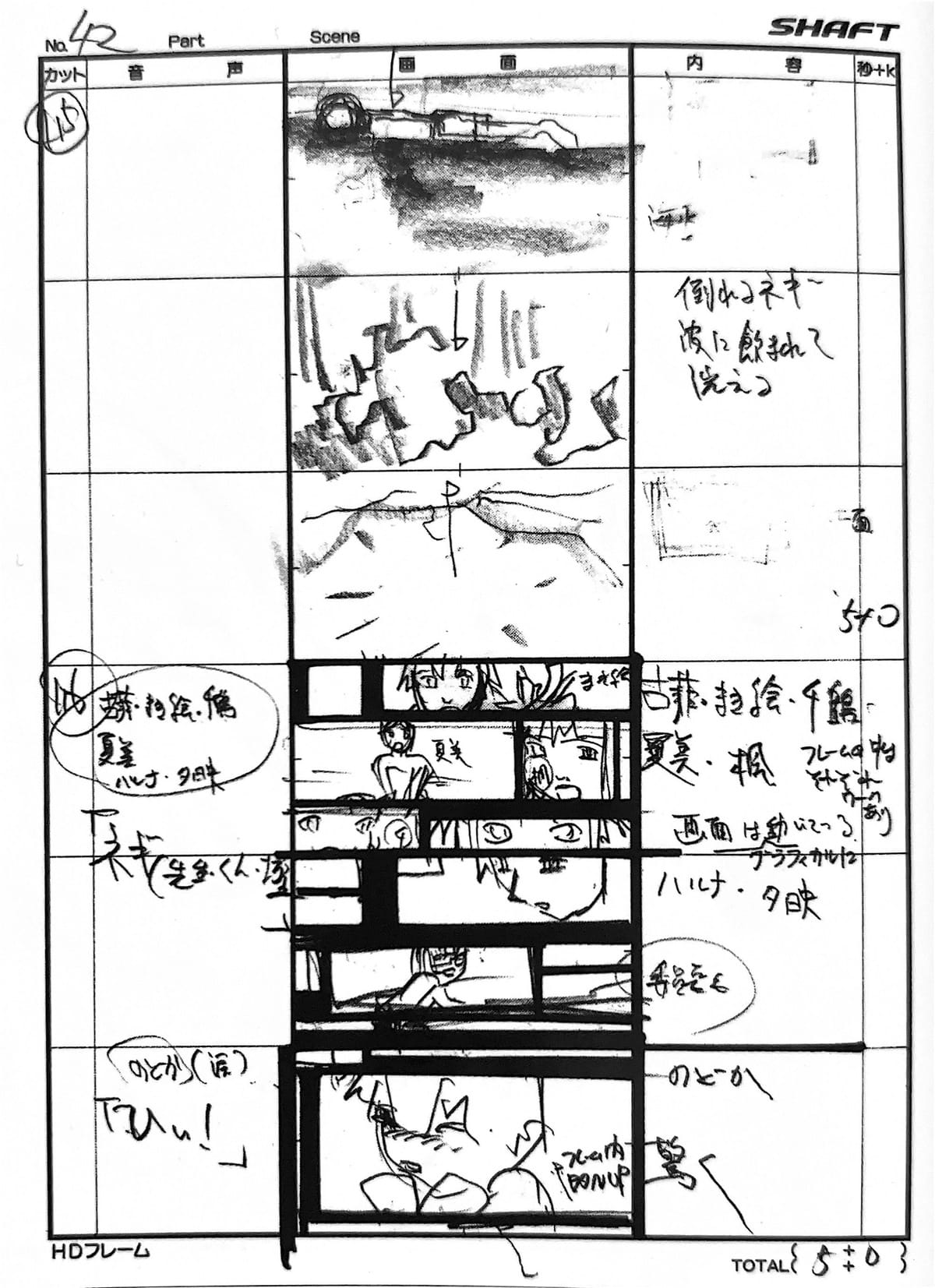
Negima!? (2006-2007)
- Director (監督): Akiyuki Shinbo
- Chief Director (チーフディレクター): Shin Oonuma
This “chief director” credit here is very strange. In the 1970s and 1980s (mainly), this was essentially the same thing as "director" (監督) or "chief director" (総監督). Nowadays, it’s equivalent to “assistant director” or “series director.” I have two examples to assert this: High School DxD Hero has Tooru Kitahata credited with this “chief director” role in the promotional videos and official website, but in the show, he’s given a form of “assistant director” (助監督). Relevant to SHAFT, Kenjirou Okada has the ‘chief director’ (チーフディレクター) role on RWBY: Ice Queendom; meanwhile, Toshimasa Suzuki calls him the ‘series director’ in an interview.
In the case of Negima!?, it’s probably more or less the same as Pani Poni Dash. Oonuma actually storyboarded the first episode of Negima!?, so he was involved in at least that capacity early on.
Hidamari Sketch (2007-2013)
- Season 1
- Chief Director (総監督): Akiyuki Shinbo
- Chief Director (チーフディレクター): Ryouki Kamitsubo
- Director (監督): Masayuki Iimura (Special Episode 1 only)
- Season 2 (x 365)
- Director (監督): Akiyuki Shinbo
- Production Director (プロダクション・ディレクター): Tatsuya Oishi
- Season 3 (x Hoshimittsu)
- Director (監督): Akiyuki Shinbo
- Series Director (シリーズディレクター): Kenichi Ishikura
- Special (x SP)
- Director (監督): Akiyuki Shinbo
- Season 4 (x Honeycomb)
- Director (監督): Akiyuki Shinbo
- Series Director (シリーズディレクター): Yuki Yase
- OVA (Sae & Hiro’s Graduation Arc)
- Chief Director (総監督): Akiyuki Shinbo
- Director (監督): Yuki Yase
Nice credits, right? Shinbo will glaze every other person imaginable before he ever glazes himself–rightfully so, his comments on how Hidamari Sketch’s aesthetics and identity were built by the likes of Kamitsubo, Tatsuya Oishi (setting designer), Hisaharu Iijima (art director) are absolutely correct (as well as character designer Yoshiaki Itou). He would know best of all, but he was also quite heavily involved in the series. Kamitsubo wrote at one point that he considered Hidamari Sketch to be Shinbo’s series, and that for his season, he was just an assistant (though, again, let’s not forget that Shinbo praises Kamitsubo’s work several times).
Of every series Shinbo has been involved with at SHAFT, Shinbo has drawn the most storyboards for Hidamari Sketch. I mean drawing them from scratch, rather than making corrections. Over the course of the show’s nearly 7-year run, he drew eight total episode storyboards under three different pseudonyms (Souji Homura, Futoshi Shiiya, and Satoko Shindou). That doesn’t sound like a lot, but in second place is any series he drew one episode's storyboards, unless we’re counting mass storyboard revisions, but I’ll get into that later. Shinbo also checked all of the storyboards for each season of Hidamari Sketch, and I don’t think there’s a season where he designated that job to someone else.
Hidamari Sketch is one of Shinbo’s children, in a way. For the first season, I would presume Kamitsubo joined the project as "chief director" a little later on during production but not late pers se; and Shinbo was also busy with both Sayonara, Zetsubou-Sensei and seeing Negima!? to the end with Oonuma (as well as overseeing Oonuma’s own solo-directing work, Ef), which may have left him less active during production. In season 2, by Shinbo’s request, Oishi took on a semi-directing role where he’s involved in checking things episode-by-episode and has an authority over certain factors (at least, to my understanding based on how Shinbo and Oishi described the role in the Hidamari Sketch guidebooks). Oishi ended up not doing an opening for the second season of Sayonara, Zetsbou-Sensei due to his work with this season of Hidamari Sketch, which Shinbo humorously described as going on "a rampage."
Season 3 was more cut-and-dry with Ishikura being chosen later in pre-production or right before production started and taking over for most of the production itself, with Shinbo overseeing. SP has no co-director; that’s straight up just Shinbo directing the two episodes.
Season 4 had the debut of Yuki Yase in what is probably very similar to Ishikura’s assumed situation: according to Yase, he was originally just asked to direct the opening animation and the first episode. Eventually, the ending animation was also handed to him, and then he was asked if he wanted to be the series director. By the time Yase was in the role of “series director,” the storyboard orders up until episode 8 had been completed. For the final OVA, Yase was involved from the start as director, so Shinbo took on the "chief director" credit. Otherwise, they likely had the same jobs, with the only difference being Yase having input from the start of pre-production.
I do want to point out that, as Tsukuyomi has indicated (and has been confirmed for a lot of his 90s/early 2000s works), Shinbo sometimes doesn't credit himself for work, whether it be storyboards or episode/unit direction, and it can generally be assumed that if no director or storyboard artist is credited and it’s “stylistically” Shinbo, it’s probably Shinbo. He did all of Le Portrait de Petit Cossette uncredited besides his main “director” role–in Hidamari Sketch’s case, episode 2 of the OVA is the only episode that does not credit a specific episode director, and Yase is credited as the storyboard artist. It’s food for thought, but I'm making a big assumption that he may have directed the episode.
Sayonara, Zetsubou-Sensei (2007-2012)
- Director (監督): Akiyuki Shinbo
- Chief Episode Director (チーフ演出): Yukihiro Miyamoto, 2008-2010
- Assistant Director (副監督): Naoyuki Tatsuwa
SZS is a Shinbo directorial work. Tatsuwa’s role is given as “assistant director,” but he had the more miscellaneous niche job of being the gag funny man as he is a huge Kouji Kumeda fan–but he was not operating in the scope of a traditional “assistant director.” Miyamoto joined as chief episode director after season 1 (the first OVA, Goku) and stayed on in that role until the third season OVA (Bangaichi).
Miyamoto's job as chief episode director saw him doing some work on every episode. He would direct some of the openings (not the OP per se) and some parts of the episodes where needed, as well as attend dubbing and art meetings when Tatsuwa was unable to make it to them. Miyamoto was also responsible for overseeing the "Weekly Zetsubou-Sensei Criticism" segments. Some of the monologues and on-screen jokes were also things Miyamoto wrote down. According to Miyamoto, neither he nor Tatsuwa were directly involved with the script meetings or storyboard checks, and those all went through Shinbo.
Miyamoto didn't go to the drawing meetings for each episode either, and only went to the ones he was in charge of as a normal episode director. Tatsuwa, on the other hand, did attend all of the drawing meetings for each episode. Tatsuwa also had the responsibility of checking all of the layouts and adding materials as the aforementioned funny gag man. Originally, Tatsuwa's role on the series was something akin to "materials-adding expert", which was later simplified to just "assistant director."
Tatsuwa and Miyamoto often discussed how to do scene retakes, and they would split the work with Tatsuwa overseeing the drawing aspects and Miyamoto overseeing the direction/processing. As such, they consider themselves to have been like oddjobbers or handymen.
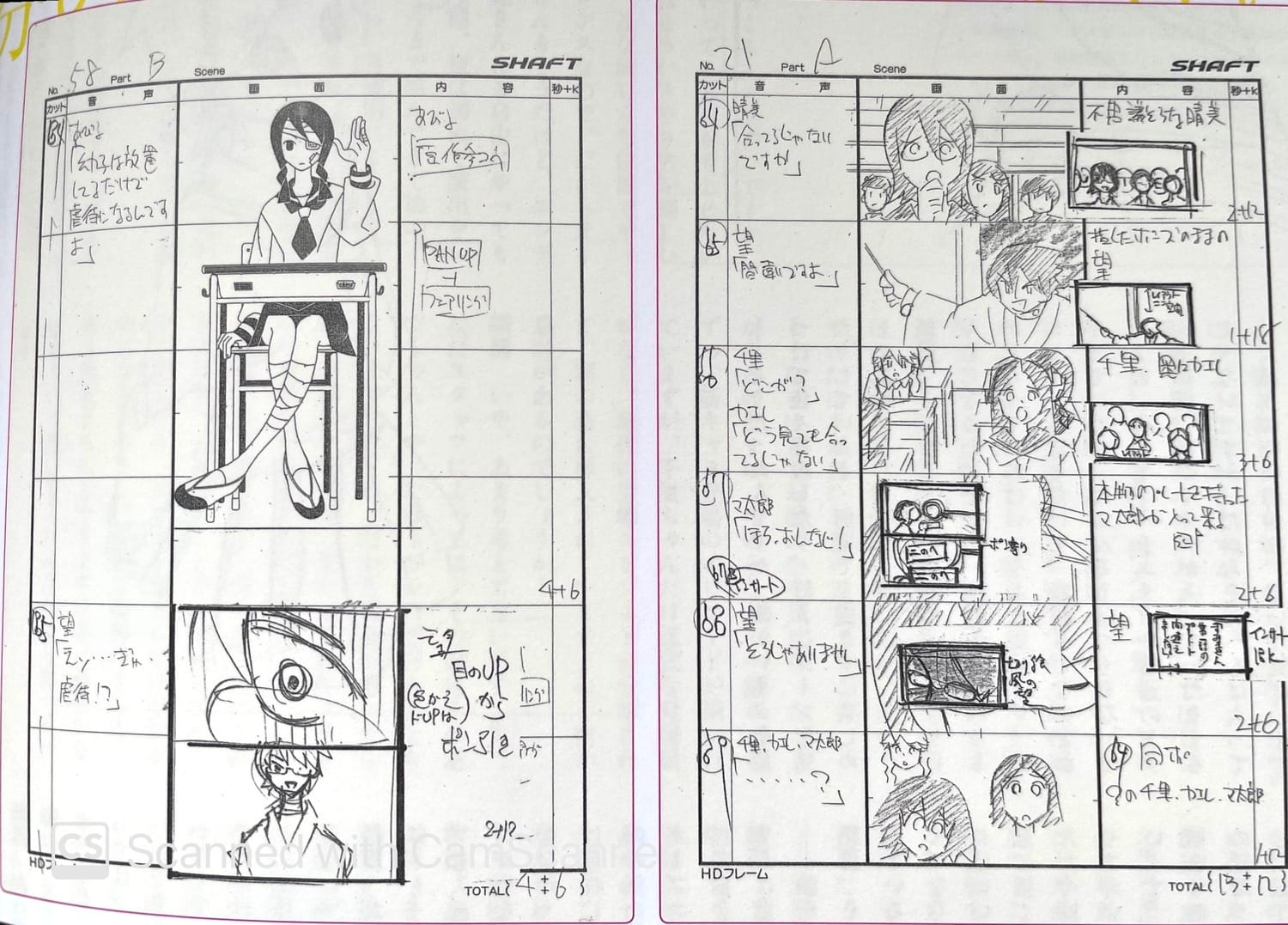
The second season also marked the first time Shinbo became significantly more involved with the structure of the anime he was making through the “series composition” credit that he has received every so often since then. The funny and ironic thing about this is how much he’s changed as a director since the 90s. In the 90s, Shinbo was so preoccupied with the visual presentation that he “left the organization” in its entirety up to his common collaboration writers like Mayori Sekijima, but into the late 2000s, Shinbo became increasingly involved in the narrative structure of anime.
Ef: A Fairy Tale of the Two (2008)
- Director (監督): Shin Oonuma
- Supervisor (監修): Akiyuki Shinbo
This is Oonuma’s work. So what did Shinbo do? I don’t know, but I’m going to assume that he probably attended things like script meetings and gave out some ideas, but otherwise it’s Oonuma work. SHAFT also doxxed (humorous) that he storyboarded episode 2 under one of his pseudonyms.
Negima OVAs (2008-2010)
- Chief Director (総監督): Akiyuki Shinbo
- Director (監督): Hiroaki Tomita (S1E1), Yukihiro Miyamoto (S1E2), Tomoyuki Itamura (S1E3), Koubun Shizuno (S2E1-2), Tomokazu Tokoro (S2E3-4), Tatsufumi Itou (S2E5)
I don’t know why this series was made like this, but my guess is Shinbo did the pre-production like normal, and each director was either there for that and intended to take control of an episode or two, or they were just given control of the episodes after the fact.
These OVAs were co-produced by Studio Pastoral, who had ties to SHAFT as an outsource studio on Tsukuyomi (and several titles since), and whose president (Yuuji Kanno) had ties to them as far back as 2001 with Cyborg 009: The Cyborg Soldier co-produced by Japan Vistec, who outsourced episodes to SHAFT.
Bakemonogatari (2009-2010)
- Director (監督): Akiyuki Shinbo
- Series Director (シリーズディレクター): Tatsuya Oishi
- Visual Director (ビジュアルディレクター): Nobuyuki Takeuchi
Another more-or-less cut-and-dry situation: in Bakemonogatari, Shinbo was directing on his own until he got Tatsuya Oishi onboard, which was during the storyboard stage. When Oishi joined, the storyboard orders had been completed up to episode 5 (the last episode boarded by Takeuchi). Shinbo continued having an influence and say in production while Oishi was given otherwise free rein.
For the storyboards, you can see from episode 1 that Oishi was doing his own corrections alongside Shinbo. From what I’ve heard secondhand is that Oishi and Shinbo split the episodes they checked, though Oishi ended up looking over some of the ones Shinbo was supposed to check or did check already as well. Shinbo again has the series composition credit, and for all of Monogatari, he and the staff basically organized the structure of the series themselves.
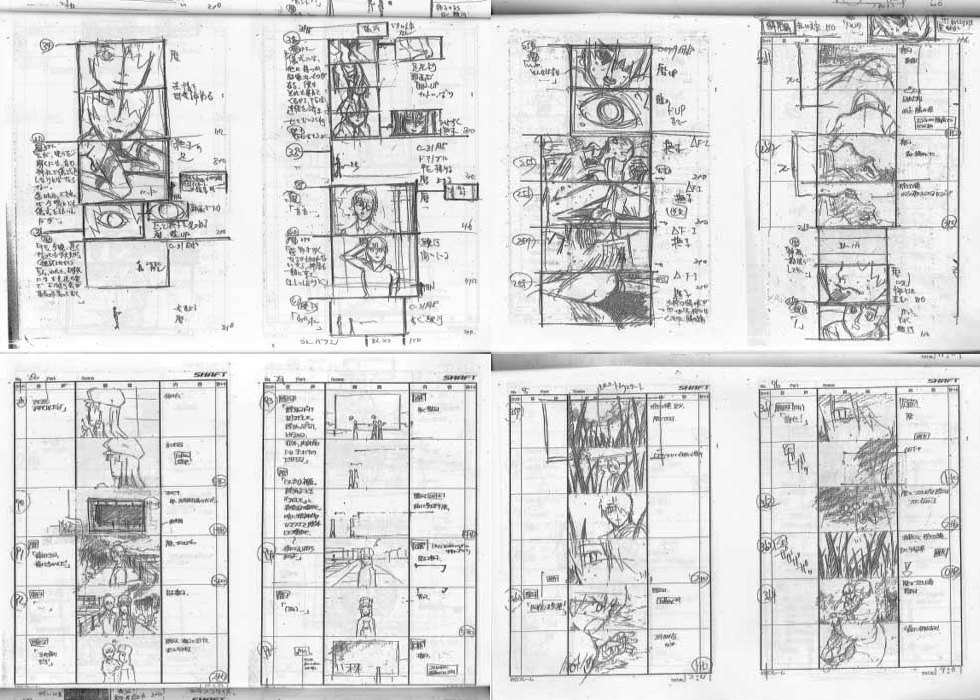
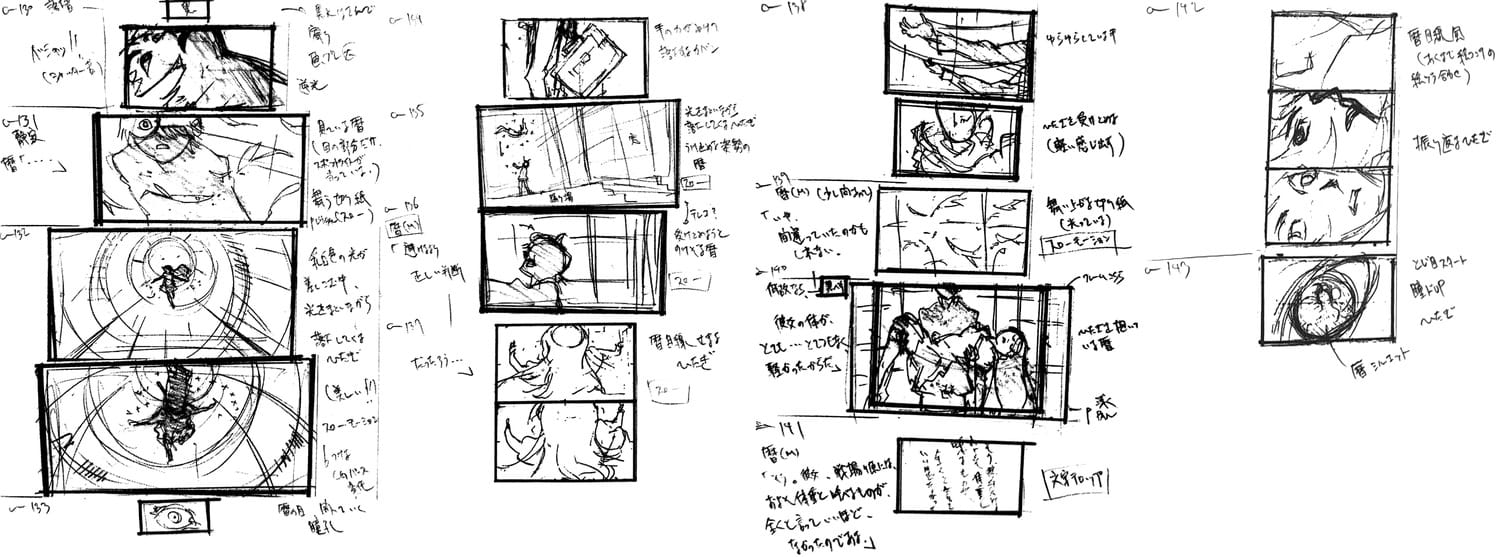
Left: Ei Aoki's storyboards for Bakemonogatari episode 10, with corrections by Shinbo. / Right: Tatsuya Oishi's storyboard corrections for the first scene in episode 1.
Maria Holic (2009)
- Director: (監督): Akiyuki Shinbo
- Series Director (シリーズディレクター): Yukihiro Miyamoto
- Assistant Director (副監督): Naoyuki Tatsuwa
Miyamoto’s debut as a series director. Like with the previously established pattern, Shinbo handled the majority of pre-production, and Miyamoto took over from there. Miyamoto is a bit different than all of the other mentioned directors because he doesn’t ever do storyboard corrections himself, at least not as far as any of his works under Shinbo go. While Shinbo allows for series (and even episode) directors to be somewhat free in interpreting or even, at times, transforming the storyboards, Miyamoto never does corrections to his works like other directors end up doing. For every work under Miyamoto’s direction with Shinbo, Shinbo is responsible for doing all of the storyboard checks.
Tatsuwa also worked as the assistant director and was on the show before Miyamoto was. His primary job was management of the production site and checking layouts, as well as a number of other miscellaneous jobs similar to his role on Sayonara, Zetsubou-Sensei, but seemingly more proactive.
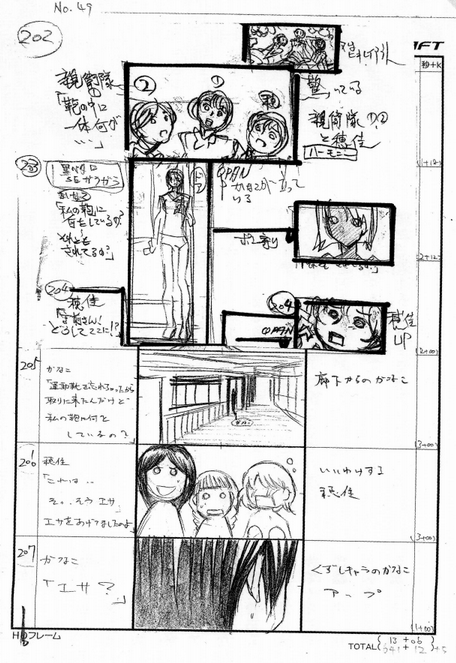
Natsu no Arashi! (2009)
- Director: (監督): Akiyuki Shinbo
- Series Director (シリーズディレクター): Shin Oonuma (S1, S2E1-7), Kenichi Ishikura (S2E8-13)
Natsu no Arashi! is two seasons, but they aired in the same year and thus were almost guaranteed to have been planned at the same time, and this is why I’m assuming Oonuma’s credit doesn’t change between them. Shinbo took on the same role of working at pre-production and then overseeing production. One of the things they’ve mentioned about this series in particular is that Shinbo had a specific order for Oonuma about finding a way to emphasize the idea of the summer heat. Shinbo had the idea of using of blocky lighting, which he took from art director Yuuji Ikeda whom he worked with on Marude, Dameo in the 1990s. Oonuma then took that idea and came up with the distinctive harshly lit look that it has.
Oonuma left the series halfway through and Ishikura took up the mantle to finish the show. For some reason, Ishikura doesn’t get credit in the series (and Oonuma’s credit is removed following episode 7), but at least SHAFT was nice enough to list Ishikura for the work on their website.
Side note, this show’s a bit funky too because it’s essentially an uncredited co-production… sort of? 16/26 total episodes (6/13 in season 1, 10/13 in season 2) are assisted by or produced by Studio Pastoral, with a number of other studios also being chipped in.

Dance in the Vampire Bund (2010)
- Director: (監督): Akiyuki Shinbo
- Series Director (シリーズディレクター): Masahiro Sonoda
I know very little about this work’s production, and it’s a little strange because it’s one of SHAFT’s few co-productions that isn’t exactly credited as such. The series was basically co-produced with ACGT, whose co-founder (Takeshi Baba) acts as the line producer (which I’ve come to presume in these contexts is equivalent to “assistant animation producer” of sorts) below SHAFT’s animation producer (CEO Mitsutoshi Kubota). I wanted to mention that because I've wondered where Sonoda was brought in from. He was pretty active around ACGT at the time (Monochrome Factor, Koi Kaze), and he co-boarded one Ef episode and directed another. Both were outsourced to ACGT.
The way I interpret this is that Shinbo was doing his usual work of pushing the series through pre-production and doing all of the checks and such, and when it came time for production, Sonoda was brought in by ACGT. With all of SHAFT's other directors and staff busy, I believe ACGT was probably called in early on to help, and a lot of the work ended up being done over there rather than at SHAFT. With that in mind, I'm guessing that Sonoda was probably the on-site director for everything being done at ACGT and may have also visited the SHAFT studio for orders and such.
Sonoda's only episodic contributions to Vampire Bund were storyboarding episodes 2-3 and later in production directing episode 2 himself, so he was probably already on the project as an episodic staff member before having to take on the bigger responsibility of series director.
Arakawa Under the Bridge (2010)
- Director: (監督): Akiyuki Shinbo
- Series Director (シリーズディレクター): Yukihiro Miyamoto
Shinbo writes up the plans and Miyamoto leads the soldiers into battle. It’s presumably just the same situation as Maria Holic for these two.
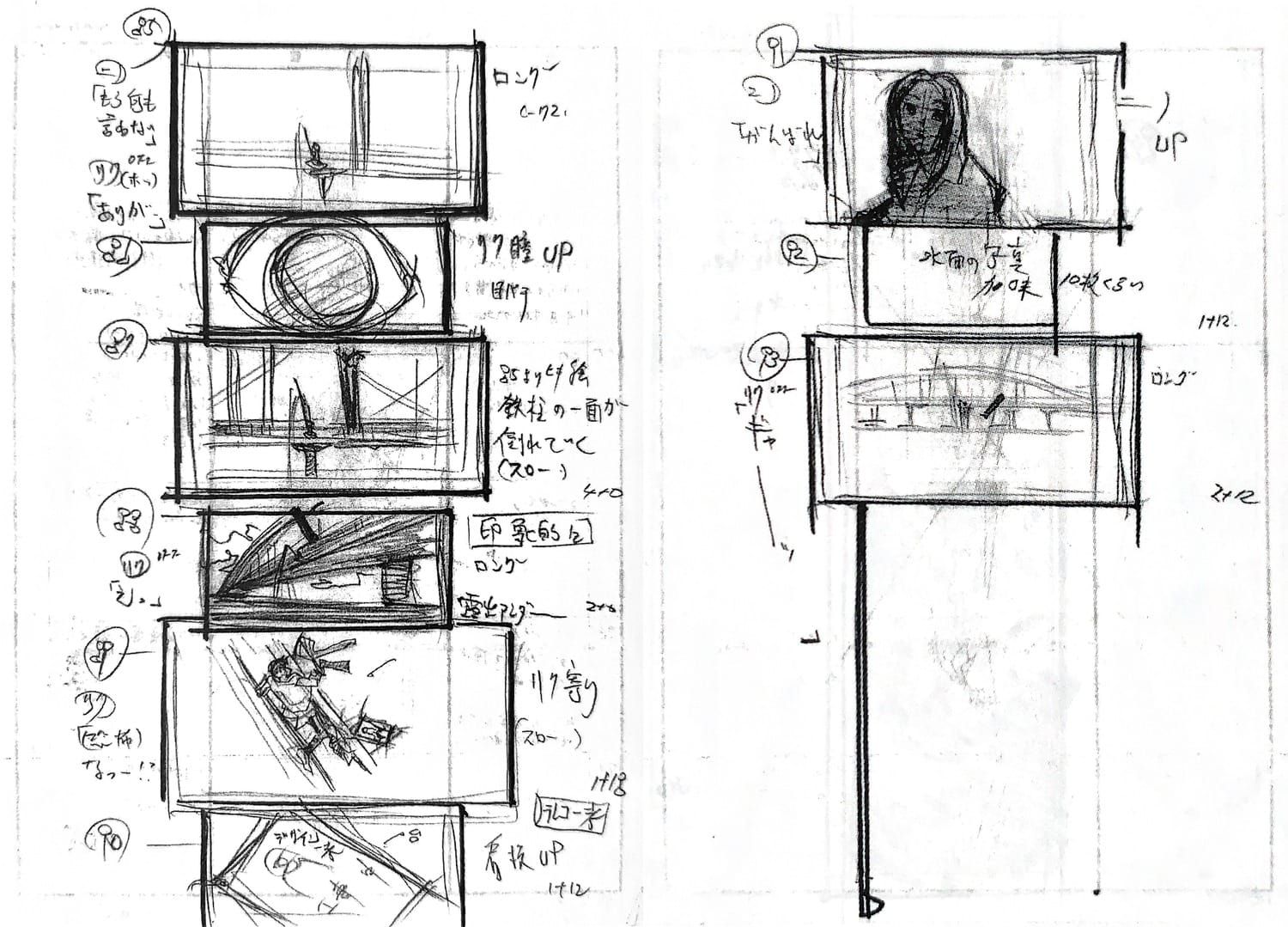
This is another of SHAFT’s sort-of co-productions. In season 1, Diomedea took control of 7 episodes, with their own line producer, CEO Makoto Kohara (who is an ex-SHAFT animator), credited in each, as well as having their own separate chief animation director from SHAFT’s. Season 2 has five episodes handled by Marvy Jack, with Hitoshi Ishii from the company (at the time) credited as production manager and their own chief animation director for their episodes as well. Episodes were also further outsourced in some cases (SHAFT --> Diomedea or Marvy Jack --> Tertiary studio).
And Yet the Town Moves (2010)
- Chief Director: (総監督): Akiyuki Shinbo
- Assistant Director (副監督): Naoyuki Tatsuwa
For this work, Tatsuwa’s role is interchangeably described as “series director.” He was officially given "assistant director," but Shinbo calls him "series director" in an interview. Very little that I can say here again, I would interpret it as being similar to the Miyamoto works. Maybe it’s just that Tatsuwa was already pretty involved as a storyboard artist and was planning to direct several episodes before he was given the role, so they gave him a different credit–I don’t know, I can’t make a good guess on this one. It could just be a completely meaningless credit difference, but either way, Tatsuwa was more involved with the whole production this time around.


Left: Storyboards for And Yet the Town Moves episode 3 by Naoyuki Tatsuwa, with corrections by Shinbo in the top three panels / Right: Storyboards for episode 7 by Tomoyuki Itamura, with corrections by Shinbo in the middle panels.
Puella Magi Madoka Magica (2011)
- Director: (監督): Akiyuki Shinbo
- Series Director (シリーズディレクター): Yukihiro Miyamoto
Shinbo is the director while Miyamoto again leads the soldiers into battle. Basic plans for Madoka started in October 2008. During all of pre-production, Shinbo was the sole director attached to Madoka. Through the hiring of Urobuchi, Ume Aoki, Yuki Kajiura, Gekidan Inu Curry, and so forth, he was the only director attached, and also did all of the storyboard checks and revisions himself. Miyamoto was busy working on Arakawa when he first started to see and notice the materials floating around the SHAFT office, and he joked about how he knew that Madoka was going to be the series that would steal away the resources from him. Little did Miyamoto know that he would be stolen too.
Miyamoto joined the project as the series director about four months before the show started broadcasting (around September 2010 or so). Not a lot of time, but he got it done, and he was certainly the series director on duty. It wouldn’t have worked without him.
I think too many people give Shinbo too little credit and too much credit for Madoka. It’s the same with Monogatari–these series are quintessential to the topical question of what Shinbo did. It is integral to emphasize just how important he is to not just the aesthetics on a company-brand level for SHAFT and the series itself, but also the fundamental aspect that is his method of directing stories. Of the first 42 cuts in episode 1’s storyboards, Shinbo either gave minor corrections to or completely revised more than half (somewhere around 24), including the first seven cuts in the series altogether.
The aesthetics were also made largely with Shinbo's sensibilities in mind. The black-and-white checkered setpiece in the first scene of the first episode was something Shinbo wanted and was inspired by artist Yukinobu Hoshino. The atmospheric quality was also the culmination of the director's efforts to combine magical girl elements, like he had directed with Magical Girl Lyrical Nanoha, and the expressions of his gothic Le Portrait de Petit Cossette OVA years earlier.
In his first meeting with them, Shinbo even told production designers Gekidan Inu Curry (who later received an "alternate world design" credit) that he wanted them to think of Madoka as an extension of Cossette and unlike Nanoha. Writer Gen Urobuchi, having never written a magical girl work before, took much inspiration from Hidamari Sketch (more so the manga, though, I believe) and Nanoha, and it wasn't until he watched Cossette that he felt as though he could combine the elements to write the series. Gekidan Inu Curry's involvement was the icing on top for him.
On the topic of storyboard corrections, Gekidan Inu Curry were also given lots of wiggle room with adding to the lore of Madoka through their witch designs and later making their own corrections across the project. They weren’t looking to just design cool things, they were looking to tell their stories. For the witch scenes, both members–Doroinu and 2shiroinu–contributed to both the script and storyboard revising processes as Shinbo had authorized them to do, which is very interesting since this is probably the only Shinbo series I can think of where non-directors or non-storyboard artists revise the storyboards. Urobuchi mentioned that the themes and motifs connected to Faust and Through the Looking-Glass were not his ideas, but rather Gekidan Inu Curry's.
There's also the peculiar case of episode 9, which has a storyboard credit given to a pseudonymous “Noriko Nanashima” that was, for a while, thought to be one of Shinbo’s pseudonyms, but some of the storyboard pages are available and they’re definitely not Shinbo's work. Instead, as some of the other storyboard pages to the episode suggest, Shinbo heavily corrected the storyboards which is why it feels a lot like his work—but he was neither the original artist nor sole artist of the storyboards, a necessary distinction to make.
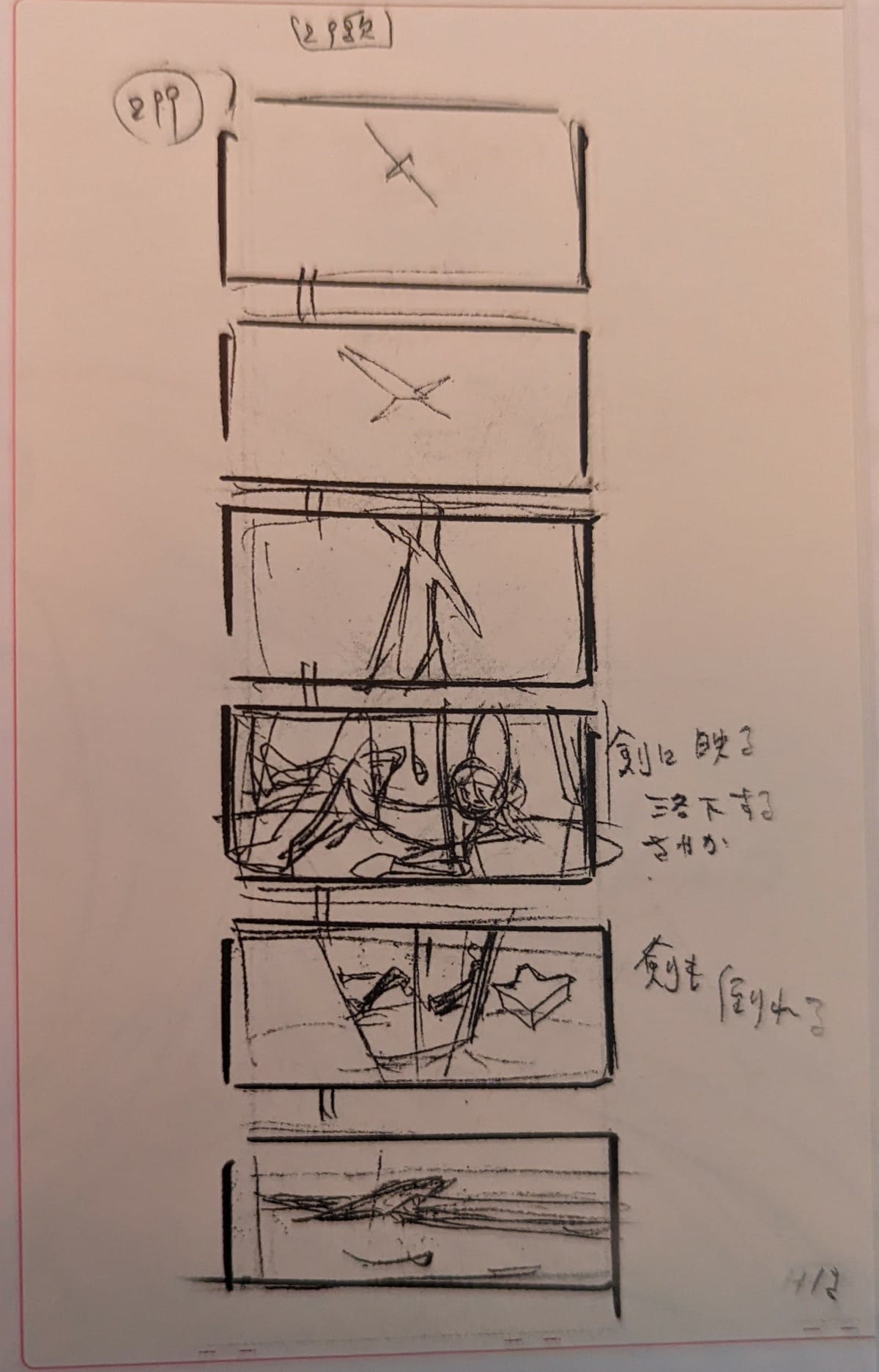

Left: Shinbo's storyboard corrections for Madoka Magica episode 5 / Right: Shinbo's storyboard corrections for episode 9
Ground Control to Psychoelectric Girl (2011)
- Chief Director (総監督): Akiyuki Shinbo
- Series Director (シリーズディレクター): Yukihiro Miyamoto
I have no clue why Shinbo has "chief director" as opposed to "director," and I know little about this show’s background. The likely scenario is that the credit doesn’t matter, and it’s just another Shinbo-Miyamoto work. It may be that he simply wasn’t involved nearly as much as the others due to busyness with Madoka Magica and the Negima Anime Finale movie (there are two other series that aired this year, but as you'll find out, he was less involved with them).
Series writer Yuniko Ayana also revealed that Shinbo drew the storyboards for the avant (cold-open) of episode 12. That episode was only credited to Shinsaku Sasaki, but that seems to be somewhat of a common theme with Shinbo's work: many of the avant sequences in his anime have much more of his specific flavor than other parts of the series. Madoka Magica avants are done in different aspect ratios, for example, and are often stylistically distinct compositionally, which makes me think that Shinbo often either tends to heavily correct or draw the avants himself. Worth noting that it ties in with Shinbo's philosophy of hooking the audience at the start of a series or episode.
Maria Holic Alive (2011)
- Chief Director (総監督): Akiyuki Shinbo
- Series Director (シリーズディレクター): Tomokazu Tokoro
- Assistant Director (副監督): Kenichi Ishikura
The last of SHAFT’s sort-of co-productions, this time again with Studio Pastoral, which has credit in all episodes and whose CEO is co-animation producer with SHAFT’s CEO.
Given Tokoro’s credit, Shinbo was probably active in pre-production. Taking into account the production circumstances, most of the work was handled at Pastoral, which supplied the production desk, chief animation directors, and most of the episodic staff, as well as most of the episode production assistants. Tokoro had minimal experience with SHAFT through the Negima OVAs (co-produced by Studio Pastoral), so either Ishikura may have been added on to help with the “style” aspect (Ishikura worked as the director of the SHAFT production site and Tokoro as the director of the Pastoral production site), or they just needed more help.
Katte ni Kaizou (2011)
- Chief Director (総監督): Akiyuki Shinbo
- Director (監督): Naoyuki Tatsuwa
Here’s a work where Shinbo did truly nothing. Tatsuwa did the storyboard corrections and handled most of the other work. Shinbo comments that he was more like a supervisor (akin to Ef) than a chief director, so he likely attended meetings and may have given suggestions/ideas, but Tatsuwa was the director otherwise fully in charge.
Negima Anime Final (2011)
- Director (監督): Akiyuki Shinbo
- Assistant Director (副監督): Kenichi Ishikura
Credited as both director and series composition, Shinbo obviously handled a lot of the organization for what the film adapted and how, though I’m unsure what Ishikura’s credit here delegates him as. This film turned out to be a production mess with four studios attached (SHAFT x Studio Pastoral, with assistance by XEBEC and Zexcs), and I don’t know where to give Shinbo credit and where not to, but surely he oversaw the storyboards himself and did pre-production work normally. XEBEC supplied their own unit directors, and it marks the final time SHAFT and Studio Pastoral collaborate.
Nisemonogatari (2012)
- Director (監督): Akiyuki Shinbo
- Series Director (シリーズディレクター): Tomoyuki Itamura
In 2010, Oishi got busy, and Itamura was eventually chosen as his replacement for Nisemonogatari. Unfortunately, I don’t know when in the production of Nisemonogatari Itamura was chosen, but I figure since he personally handled the storyboards and direction of episode 1, that it was comparatively early on but still somewhat in the middle of pre-production. Like with Bake, Shinbo seems to have concerned himself mostly with the pre-production and left Itamura to handle most of the on-site direction. Of the 129 cuts of the storyboard to episode 2 (there are over 500 total) that I’ve seen, Shinbo revised at least 35 (27%). As Itamura’s debut, I assume Shinbo was still somewhat active in supervising the direction as well.
Puella Magi Madoka Magica Films (2012-2013)
- Chief Director (総監督): Akiyuki Shinbo
- Director (監督): Yukihiro Miyamoto
- Assistant Director (副監督): Hiroyuki Terao
Don’t get it twisted: the credit change from the TV series changes nothing about Shinbo and Miyamoto's actual jobs, according to Miyamoto. The only differences I can think of are that 1) these are films, so the credits are more aesthetic; and 2) Miyamoto was going to be the on-site director from the beginning. This time, SHAFT’s CEO asked Miyamoto to be the director when they met at a convenience store next to the SHAFT office on a nonchalant day.
Animation producer Yasuhiro Okada considered Miyamoto to be the best director for the job of expressing Shinbo’s artistic flavors. Other directors are interpretative with their use of “Shinbo style” and his ideas–for example, Hajime Ootani, whom Shinbo considers to be one of the directors most like himself, is his own stylistic entity within the realm of Shinbo-influenced directors. Miyamoto’s craftsmanship, which lacks such a prevalent ego (though not entirely devoid of one) is concerned with making things ‘right’ and in the style that is desired. Of all the directors Shinbo works with, Miyamoto is the one who can lead most "accurately" to Shinbo's vision.
For the compilation films, Shinbo worked with Rie Matsuubara, the editor, in cutting the TV series down to film-length content (thus the “film composition” credit for both) and then gave various orders regarding the retakes and redesigns, some of which were already planned since the TV series but could not be implemented due to the hectic schedule. Miyamoto then handled actually doing the work on-site. The second film also has a segment not in the TV series around the halfway point that was confirmed to be newly storyboarded by Shinbo.
Much of the same is true in Rebellion. Gekidan Inu Curry (though, specifically Doroinu) became much more involved with the series and were providing art concept designs. Shinsaku Sasaki from the TV series was hired as the storyboard artist because of how essentially perfect his episodes were (Shinbo made very few to virtually no corrections for any of his episodes). In Rebellion, Shinbo’s corrections can be seen in the storyboard pages every once in a while, but Doroinu specifically continued to use his authority and completely revised entire sections of the storyboard for the witch and alternate space segments. The tea party scene is something that was also newly written and completely storyboarded (to my knowledge) by either Doroinu or the duo together.
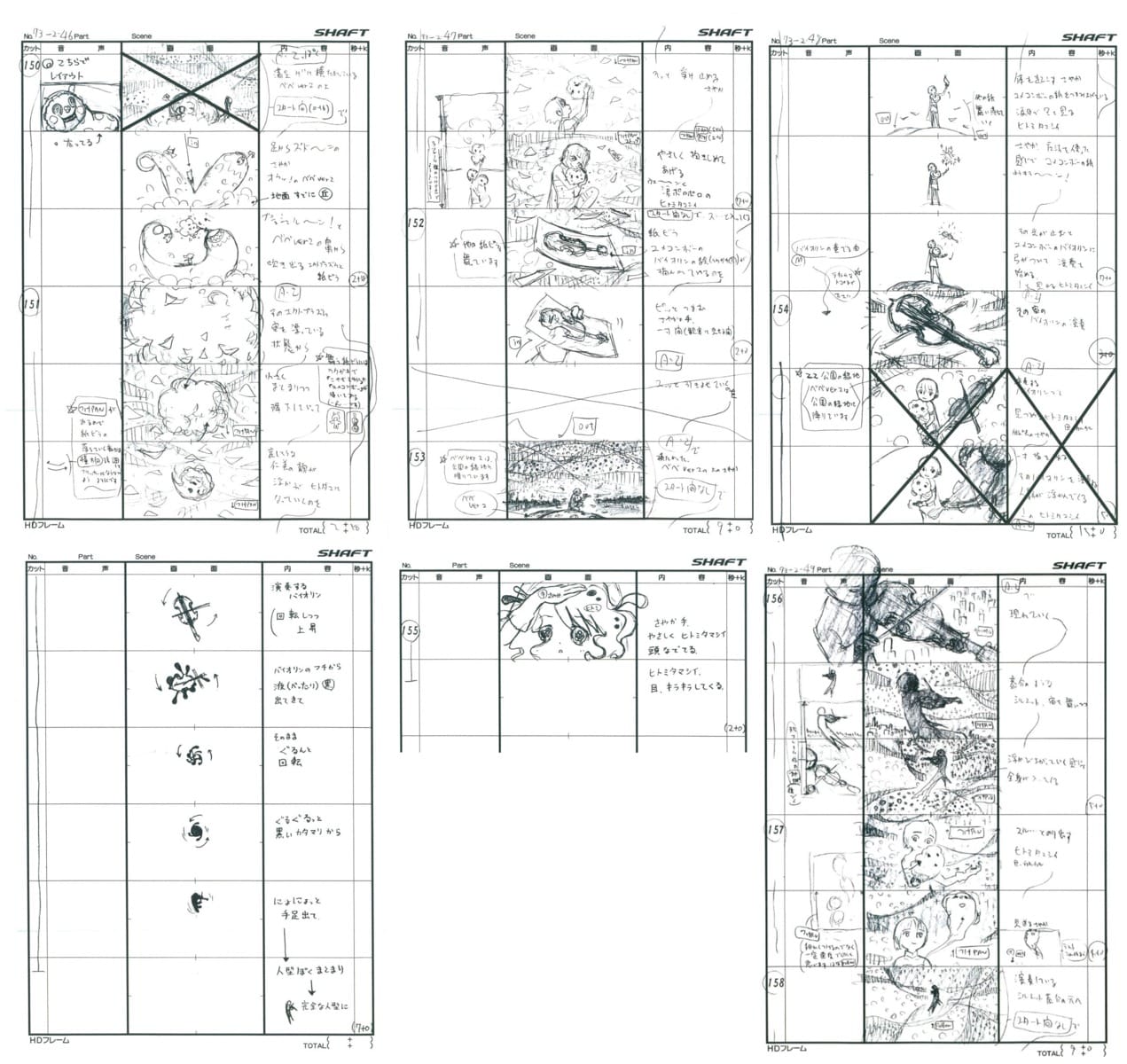

Left: Storyboards for Rebellion by Shinsaku Sasaki, with some corrections by Doroinu / Right: Sasaki's storyboards with a correction by Shinbo on C176
I’m not 100% certain on the full scope of assistant director Terao’s duties, but from my understanding, he was helping to organize and look over material, as well as doing quite a bit of the animation work in the first two films. In the third film, he said that he would draw the rough effects animations, and Takashi Hashimoto would take over. He also had a big hand with the setting design, which he is separately credited for.
Monogatari (2012-2017)
(Nekomonogatari: Black, Monogatari Series Second Season, Hanamonogatari, Tsukimonogatari, Owarimonogatari, Koyomimonogatari)
- Chief Director (総監督): Akiyuki Shinbo
- Director (監督): Tomyuki Itamura
- Series Director (シリーズディレクター): Naoyuki Tatsuwa (Kabukimonogatari, part of Second Season), Yuki Yase (Onimonogatari, part of Second Season)
Itamura took on more responsibilities following Nisemonogatari as he became involved with the Monogatari series’ new seasons from conception (pre-production) and gradually developed his capabilities and style. Shinbo continued to do storyboard checks and had a say in the show with Itamura involved in many more of those decisions too.
The tasks in Second Season (2013) were divided up a bit more due to the production circumstances, with Tatsuwa and Yase taking over one arc each. Shinbo and Itamura were likely involved in each as far as pre-production is concerned, but essentially, each arc ended up being led by those directors while Itamura’s time was mostly spent on the other arcs. Both Tatsuwa and Yase ended up having the authority to change the storyboards as well.
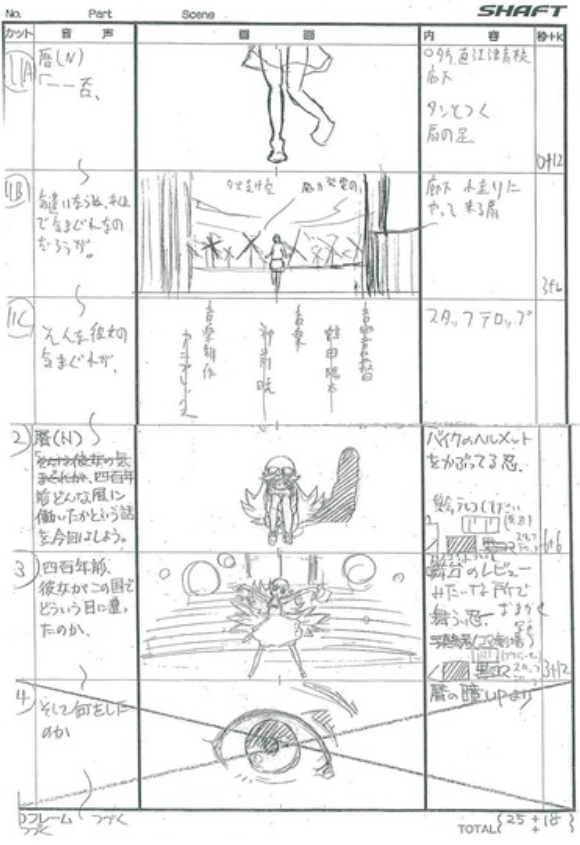

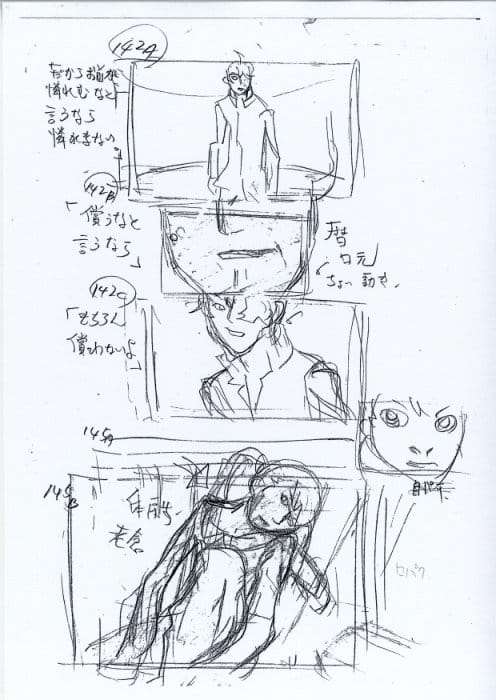
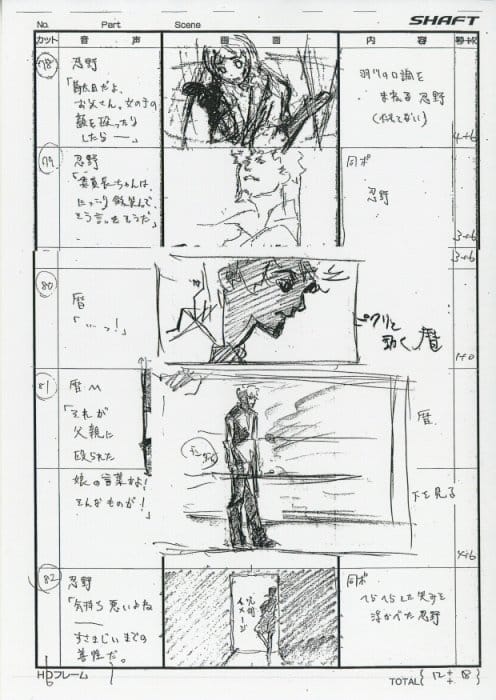
Top left: Storyboards for Onimonogatari episode 1 (Second Season episode 14) by Fumie Muroi with corrections by Yase / Top right: Storyboards for Kabukimonogatari episode 4 (Second Season episode 9) by Shinsaku Sasaki with corrections by Shinbo / Bottom left: Storyboard corrections for Owarimonogatari episode 5 by Shinbo / Bottom right: Storyboards by Tomoyuki Itamura for Nekomonogatari: Black episode 4, with corrections by Shinbo.
Sasami-san@Ganbaranai (2013)
- Director (監督): Akiyuki Shinbo
- Assistant Director (副監督): Naoyuki Tatsuwa
Another scenario in which I believe Tatsuwa’s involvement as a storyboard artist at the beginning of the storyboarding stage is why this specific credit was used for him until he was chosen to lead the project, but otherwise it should be the same situation as And Yet the Town Moves in which Tatsuwa is the “series director” and Shinbo does his usual duties.
Nisekoi (2014)
- Chief Director (総監督): Akiyuki Shinbo
- Director (監督): Naoyuki Tatsuwa
Tatsuwa was involved with Nisekoi from the start. Unlike with Katte ni Kaizou, Shinbo’s influence can still be felt throughout the series, and he was likely active during the work like with Monogatari. He’s also a series composition writer for both seasons. Unfortunately, I don’t have much material from Nisekoi to say for sure, though.
Mekakucity Actors (2014)
- Chief Director (総監督): Akiyuki Shinbo
- Director (監督): Yuki Yase
I don’t know about this one, but I assume it’s a similar situation to Nisekoi, with Yase chosen to direct at the beginning. The only corrections I can spot on the few storyboards I've found look to be Yase’s.
Gourmet Girl Graffiti (2015)
- Chief Director (総監督): Akiyuki Shinbo
- Director (監督): Naoyuki Tatsuwa
Yoshiaki Itou once commented on Shinbo being particular about the look of the food and the staff needing to get his approval, but I have no other examples of his directing work from the series. Considering the type of series and that Tatsuwa seems to have been involved from the start, I would bet it's more Tatsuwa's show than Shinbo's.
Nisekoi: (2015)
- Chief Director (総監督): Akiyuki Shinbo
- Chief Episode Director (チーフ演出): Yukihiro Miyamoto
Probably the strangest difference in director credits in this entire list. Tatsuwa was busy with Gourmet Girl Graffiti and might have been attached to this sequel series at one time, but he ends up leaving SHAFT this year. Miyamoto wasn't brought onto the project as a series director and was instead given this role that he had on Sayonara, Zetsubou-Sensei. I’m making the assumption that Miyamoto was not as involved as he was in directing Madoka, but he did end up having supervisory authority over the production to a degree. Shinbo's role is probably the same as what he did on the first season, but there's a noticeably drastic difference in approach to the product. With Tatsuwa gone and Miyamoto seemingly around to oversee all of the episodes, Nisekoi: seems to have lacked a proper director.
Kizumonogatari (2016-2017)
- Chief Director (総監督): Akiyuki Shinbo
- Director (監督): Tatsuya Oishi
Kizumonogatari is another work where Shinbo did very little hands-on work. Oishi was slowly working away at the project since 2010 (most of which was just storyboarding and ideating, as the animation work didn’t start until the spring of 2014). Shinbo was still involved with the meetings, the screenplay composition, and maybe helping out Oishi–but the trilogy is definitely Oishi’s work with its French New Wave homages, stylistic approach, and aesthetic. Aside from being involved with the film composition, it doesn't seem like he made any corrections to the storyboards either.
Later on, the Koyomi Vamp version of the films that condensed the work into a single movie (Aniplex’s CEO was just interested in Kizumonogatari as a “serious vampire story” interpretation of the novels, which Oishi thought was interesting) credits only Oishi as the film’s director. I don’t think Shinbo had anything to do with Koyomi Vamp itself, but the credit he received on the movie is “planning assistance” (企画協力).
Kubikiri Cycle / The Zaregoto series (2016-2017)
- Chief Director (総監督): Akiyuki Shinbo
- Director (監督): Yuki Yase
Shinbo is again the chief director and series composition writer, so he was likely involved heavily with the organization of the work and how it was adapted (or what was adapted), but Yase was also involved from the start. Very little from the series feels strikingly Shinbo-like, which leads me to believe that Yase, for the most part, was in charge.
Episode 2 is one of those rare cases where a storyboard artist isn’t credited, which led a lot of people to speculate that it was Shinbo’s uncredited boards–but when watching the episode, there’s not a Shinbo-like air to it. Eventually, four storyboard pages were uploaded online, but they didn’t help identify the storyboard artist because there were two drawing styles, one of which was obviously corrections, but neither of those was Shinbo’s or Yase’s. While in conversation with Animmony one day, we deduced that there are three people involved with the storyboard examples we have: episode director Takuma Suzuki, Yase’s handwriting giving instructions and notes as corrections, and an unknown artist who cleaned up the drawings and made corrections based on Yase’s notes. The full rationale for this deduction is given in the link above or can be found on one of the Sakugabooru pages.
March Comes In like a Lion (2016-2018)
- Director (監督): Akiyuki Shinbo
- Series Director (シリーズディレクター): Kenjirou Okada
Okada worked on all of SHAFT’s works in 2015 and visited Shin-Ei Animation to direct three episodes on one of their shows, so I believe March is a case of the series director being chosen partway through pre-production, with Shinbo directing on his own prior to that. Shinbo was also responsible for the series composition.
The show aired for two seasons with Okada receiving the same credit for both, so it's likely similar to Natsu no Arashi! in that it was greenlit for two seasons from the beginning.
Shinbo was generally responsible for the storyboard corrections as a whole, to my knowledge. Okada also did touch a lot of the storyboards as well, but as far as I know he wasn’t doing corrections, or at least very many of them. Instead, his work can be seen as various color notations on the storyboards. I originally misidentified the colored notations to be Yoshiko Mikami’s due to the fact that all of the examples of them appearing were on Mikami’s episodes–until I saw that Mie Ooishi’s boards showed up and the same notations appeared. Okada’s later work directing Black Butler: Public School Arc (2024) had the same kind of notations, which more or less confirms them to be his doing.
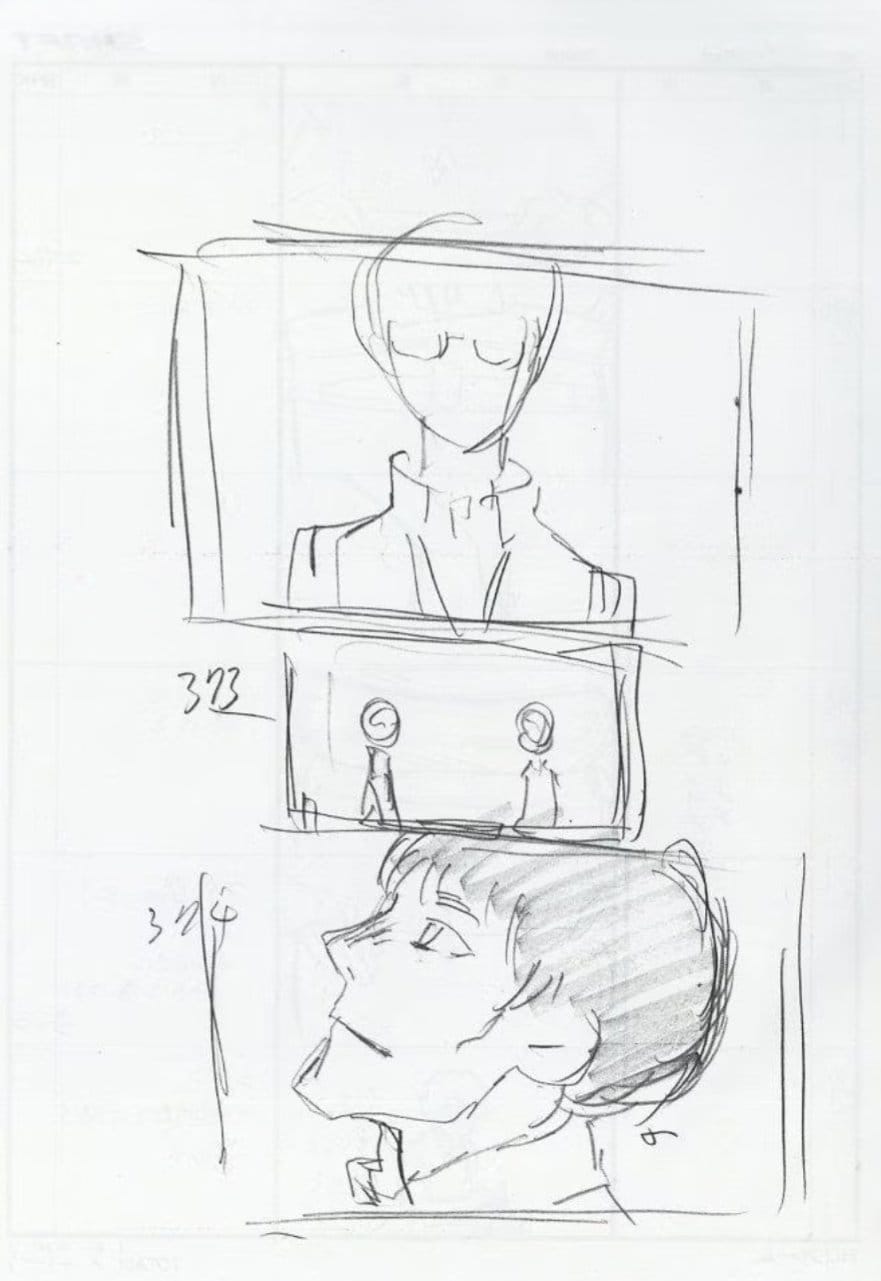
Fireworks (2017)
- Chief Director (総監督): Akiyuki Shinbo
- Director (監督): Nobuyuki Takeuchi
- Assistant Director (助監督): Seimei Kidokoro
It’s Takeuchi’s movie. From the interviews I read, primarily from the film’s theater pamphlet, it seems like Shinbo was semi-active in pre-production and made several suggestions regarding the setting, story, characters, and such, but otherwise he said that he didn’t do much on the film. Takeuchi drew all of the storyboards himself and led the project. I think Kidokoro’s role was originally that of just a unit director, but he eventually was operating as an assistant director, at least as far as his comments lead me to believe. The movie had a rough production and needed heavy assistance from other studios, namely Lay-duce, so that makes sense as a guess.
Fate/Extra: Last Encore (2018)
- Chief Director (総監督): Akiyuki Shinbo
- Series Director (シリーズディレクター): Yukihiro Miyamoto
As Miyamoto is the series director, Shinbo was responsible for doing all of the storyboard checks. Aside from that and general pre-production, he seems to have been relatively hands-off, and Miyamoto pushed it through. These are the same credits the two had for Ground Control to Psychoelectric Girl, which I still don't really understand.

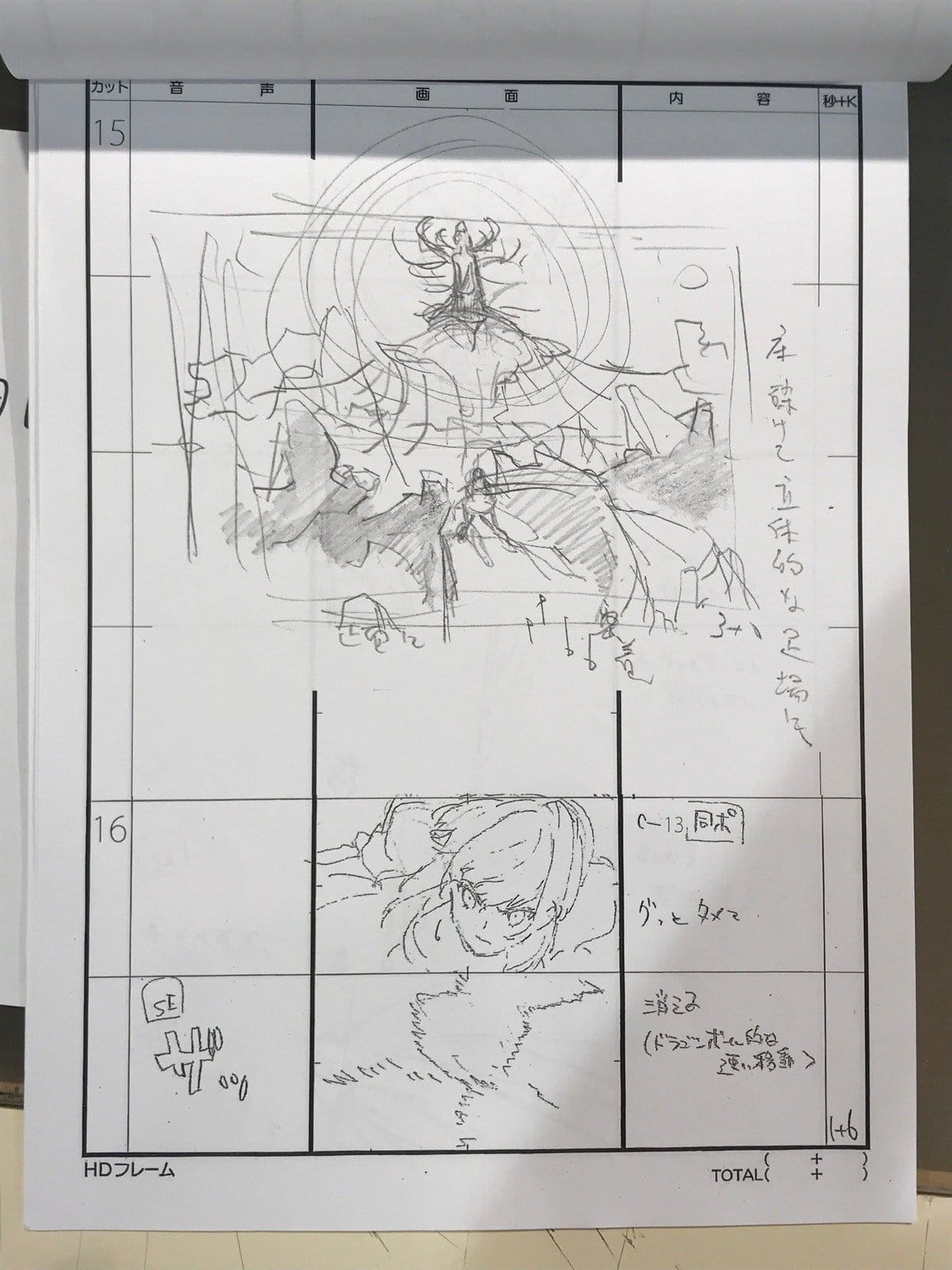
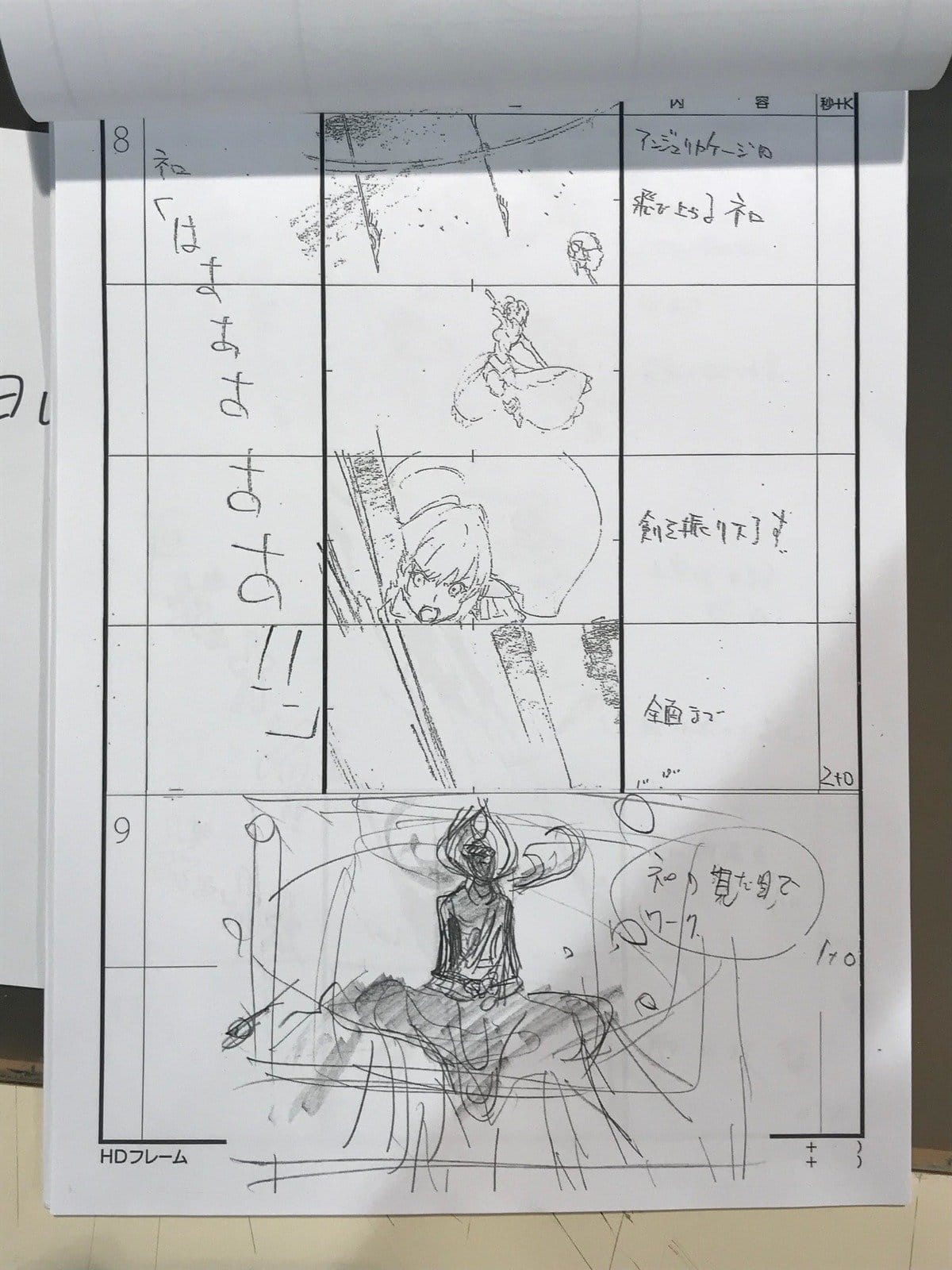
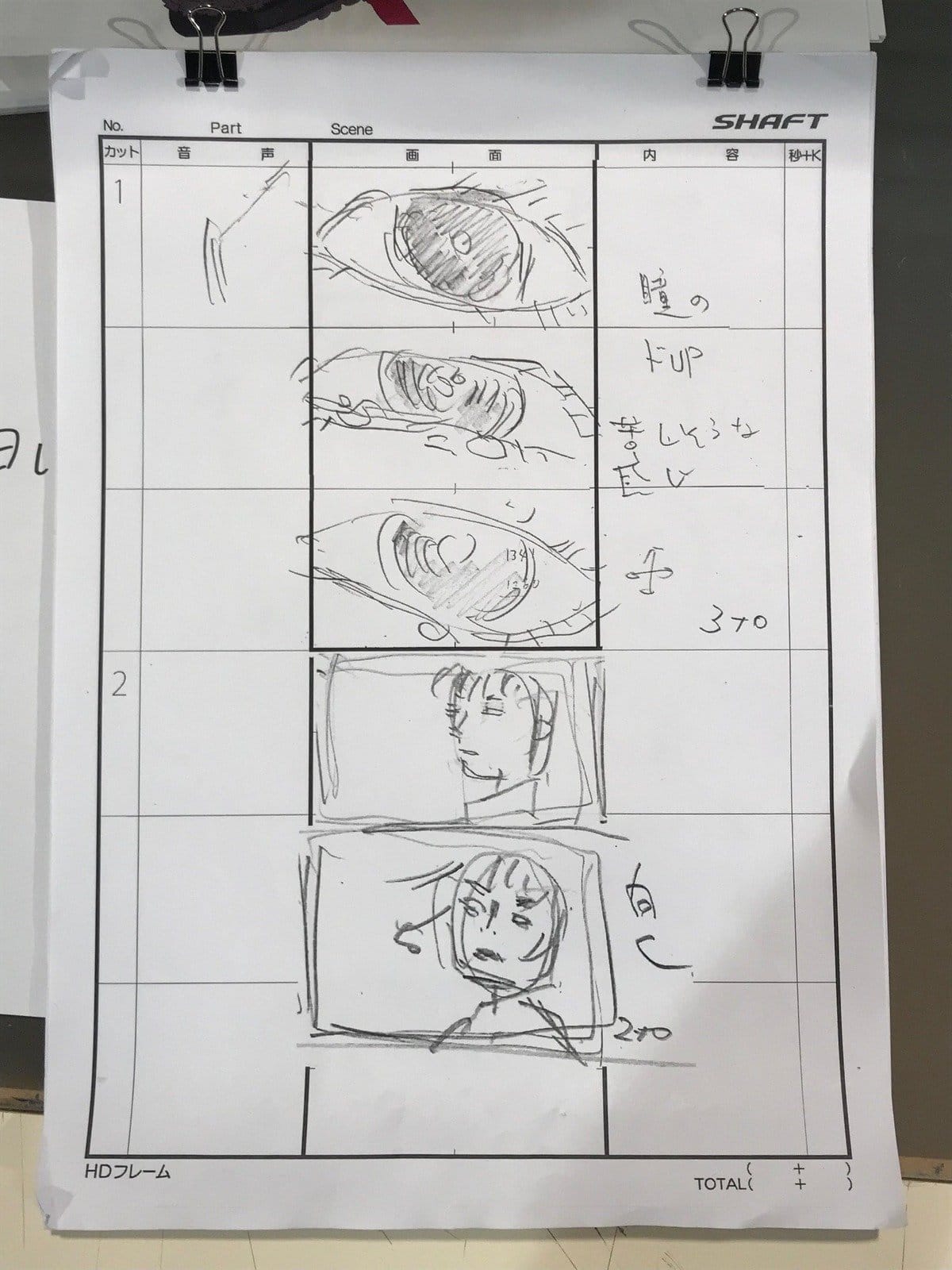
Storyboards for episode 1 of Fate/Extra: Last Encore by Yukihiro Miyamoto and Kazuhiro Miwa, with corrections by Shinbo.
Zoku Owarimonogatari (2018)
- Director (監督): Akiyuki Shinbo
Itamura left SHAFT to do his own thing and with the other directors busy and no clear successor, Shinbo ended up directing Zoku Owari on his own, given it was only six episodes worth of content. He would be responsible for all of the storyboard checks, pre-production, and overseeing the production. I think he probably took somewhat of a hands-off approach and let the episode directors’ work shine, which I think works given the nature of the season as a mirror world-esque story that doesn’t necessarily require a lot of oversight as far as singular-vision coherency. Its thematic abstraction is consistent with the staff approaching the work in their own ways.
It is an interesting look at some of Shinbo’s own directorial style when he’s “on his own,” though. Itamura’s later seasons introduced the concept of chapter cards that were literally cutting episodes up by the chapters they were adapting from the source material, both as a way of controlling an episode’s tempo similar to the Shinbo style of interjectory colored cuts (inherited by Oishi, Oonuma, Yase, Ootani, etc.) and also as a derivative use of Oishi’s quick-cutting flashing text–rather than have the flashing text (that you’re not necessarily meant to read), Itamura was able to cut the runtime by simply having snippets of the original light novel’s text for some of these cuts and condensing the amount of digestible information further. Shinbo doesn’t quite do what Itamura did, nor what Oishi did, but he does decide to keep that chapter-cutting separation. That’s just one example of Shinbo learning and taking ideas from those previously considered his proteges, because the master and the student are a two-way street interaction.
Some stylistic qualities of Oishi can even be felt in the Bakemonogatari manga PV that Shinbo directs (though Miyamoto processes) and storyboards in 2021.
Magia Record (2020)
- Chief Director (総監督): Doroinu
- Assistant Director (副監督): Yukihiro Miyamoto
- Director (ディレクター): Yukihiro Miyamoto, Kenjirou Okada, Midori Yoshizawa
- Animation Supervisor (アニメーションスーパーバイザー): Akiyuki Shinbo
Strange credits, but it’s easy to understand: Shinbo did not want to direct Magia Record because he didn’t think he could do it well. Doroinu, who was involved in the game’s writing, designs, and art, and had shown his capability with storytelling across Madoka prior, was chosen by Shinbo because he believed that Doroinu was capable of adapting the work. Shinbo told him not to adapt the game too faithfully because it was difficult to do so across different mediums.
Besides that, Shinbo had little influence on the work. As animation supervisor, he generally gave out some ideas, assisted with connecting the story and characters of Magia Record and Madoka, and encouraged staff.
Doroinu, inexperienced with directing a series as he was, had the help of Miyamoto, Okada, and Yoshizawa as “directors” on various episodes, where they would act as series directors for sets of episodes. Miyamoto, who was also assistant director, helped Doroinu personally. The three "directors" were chosen not just for their ability, but also because they understood directing in “SHAFT style.”
Magia Record Seasons 2-3 (2021-2022)
- Chief Director (総監督): Doroinu (Gekidan Inu Curry)
- Director (監督): Yukihiro Miyamoto
- Assistant Director (副監督): Midori Yoshizawa
- Animation Supervisor (アニメーションスーパーバイザー): Akiyuki Shinbo
Not really any different from the first season, the directors are just consolidated with Miyamoto and Yoshizawa handling the work under Doroinu, and Miyamoto still leading. Shinbo’s role is otherwise the same. Miyamoto still doesn’t do storyboard checks from what I’ve seen, but the storyboards to some episodes show corrections by both Doroinu and Yoshizawa.
Pretty Boy Detective Club (2021)
- Chief Director (総監督): Akiyuki Shinbo
- Director (監督): Hajime Ootani
- Assistant Director (副監督): Kenjirou Okada
This is a work where Shinbo lets Ootani flow. He mainly seemed concerned with pre-production, which Ootani was a part of. Shinbo was once again responsible for series composition, and during pre-production, Ootani said that he strongly wanted the last arc of the anime to be the light novel’s sixth volume, so Shinbo decided to skip over volume 5. He voiced his particular concerns about ensuring that Mayumi is the core subject of the work and that the five bishounen boys, who already stood out, didn’t stand out too much compared to her. Whether or not it was related to Ootani wanting to adapt Vol. 6, Shinbo also decided to do something different from his other works, and that is to do the cutting at the scriptwriting stage.
I don't know how involved Shinbo was with overseeing the storyboards, but my guess is that this show leans more towards Ootani's sensibilities. Ootani, on the other hand, does seem to have been quite involved with the storyboard process.


Storyboards for Pretty Boy Detective Club episode 4 by Kenjirou Okada, with corrections by Ootani.
Okada, meanwhile, may be a true “assistant director” in this case. Ootani and Okada seem to have a high level of trust in one another. Under Okada’s care, Ootani put out some of March Comes In like a Lion’s best episodes, and again, here Okada was seemingly given a high level of freedom in directing his episodes. Shinbo also commented that Ootani and Okada complement each other’s strengths and weaknesses as directors.
Monogatari Series Off & Monster Season (2024)
- Chief Director (総監督): Akiyuki Shinbo
- Director (監督): Midori Yoshizawa
The continuation of Monogatari sees Shinbo back in action as the chief director and series composition writer for the series. Unlike with other debuts in the series, Yoshizawa was immediately given the role of “director” and did not undergo a process of being “series director”, perhaps most likely because she had already been an assistant director for Magia Record. Shinbo also noted her work far before Magia Record, specifically episode 5 of Zoku Owari; but to fans of the series, it seemed likely that Yoshizawa would be chosen to lead the next era of Monogatari, a decision that was made by SHAFT's president when they first started planning the season back in late 2022.
On the topic of Shinbo’s role in this season, it’s more or less the same as before, but he’s relying on Yoshizawa for her art design sensibilities, as well as her storyboarding prowess. She’s credited in half of the season’s episodes as a storyboard artist for good reason. Shinbo was still quite active, though; even by the third episode, it was clear due to certain stylistic attributes that he was the one either directly storyboarding some of the avants or at least revising them, which culminated in the elusive appearance of “Fuyashi Tou” as storyboard artist of Wazamonogatari (OMS episodes 7-8) alongside Ryuuhei Aoyagi.
The truth of the matter is that Wazamonogatari, gothic vampire story that it is, was storyboarded by Aoyagi and then massively revised by Shinbo himself to the point of getting pseudonymous credit. That fact was at first simply supported by the stylistic indulgence, but later confirmed by Yoshizawa that he did, in fact, look over the storyboards himself.
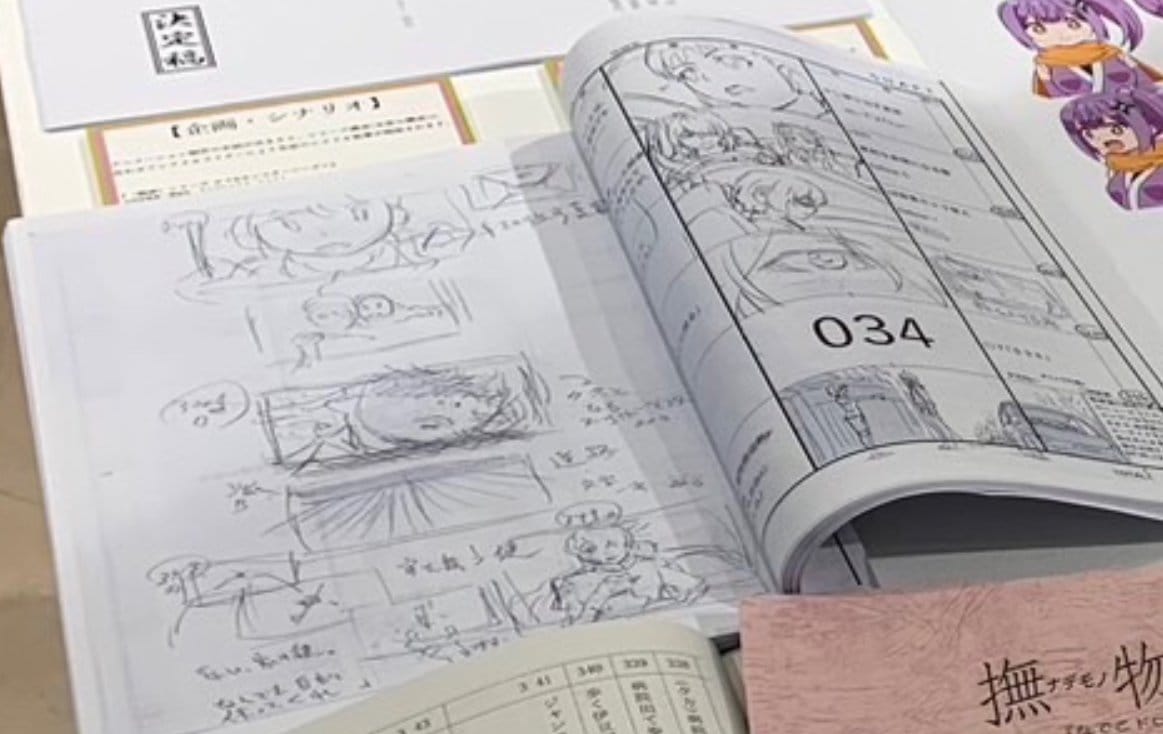
Puella Magi Madoka Magica: Walpurgisnacht Rising (2025?)
- Chief Director (総監督): Akiyuki Shinbo
- Director (監督): Yukihiro Miyamoto
There's basically no information on this movie thus far besides three trailers and a couple of the main staff being revealed. Announced in 2021, then announced for a 2024 release date, and pushed back to 2025, it seems like production is halting here and there. Since 2023, Miyamoto has had time to direct The Quintessential Quintuplets~, an episode of Mashle outsourced to SHAFT, three episodes of Monogatari OMS (and assisting another), and also direct A Ninja and an Assassin Under One Roof, airing this season.
It seems other involved staff members have also been showing up here and there: Shuuichi Kusamori created the backgrounds for the more recent key visual unveiled at Anime Japan, so he's likely working on the film to an extent. While production was on hold, it seems he got brought over to do part of the art design and background art/3D backgrounds for Wazamonogatari too.
As for Shinbo's specific role... who knows again? But unlike the original Madoka Magica TV series or Rebellion, Walpurgisnacht Rising has a rather interesting, vicious, sinister flair to it that feels much more reminiscent of Shinbo's early works, especially the strong visuality to Christian iconography (fallen angel, crosses, and such). It bears a very different visual language to the series that have preceded it.
It's also worth mentioning that Shinsaku Sasaki is presumably not returning to storyboard the film like before; and while I expect Doroinu to once again be involved in aspects of the witch design and storytelling, the general compositional elements featured in the trailer are... scarily Shinbo-like, much more than any other work in recent memory has been aside from Wazamonogatari, which he was heavily involved with revising the storyboards to.
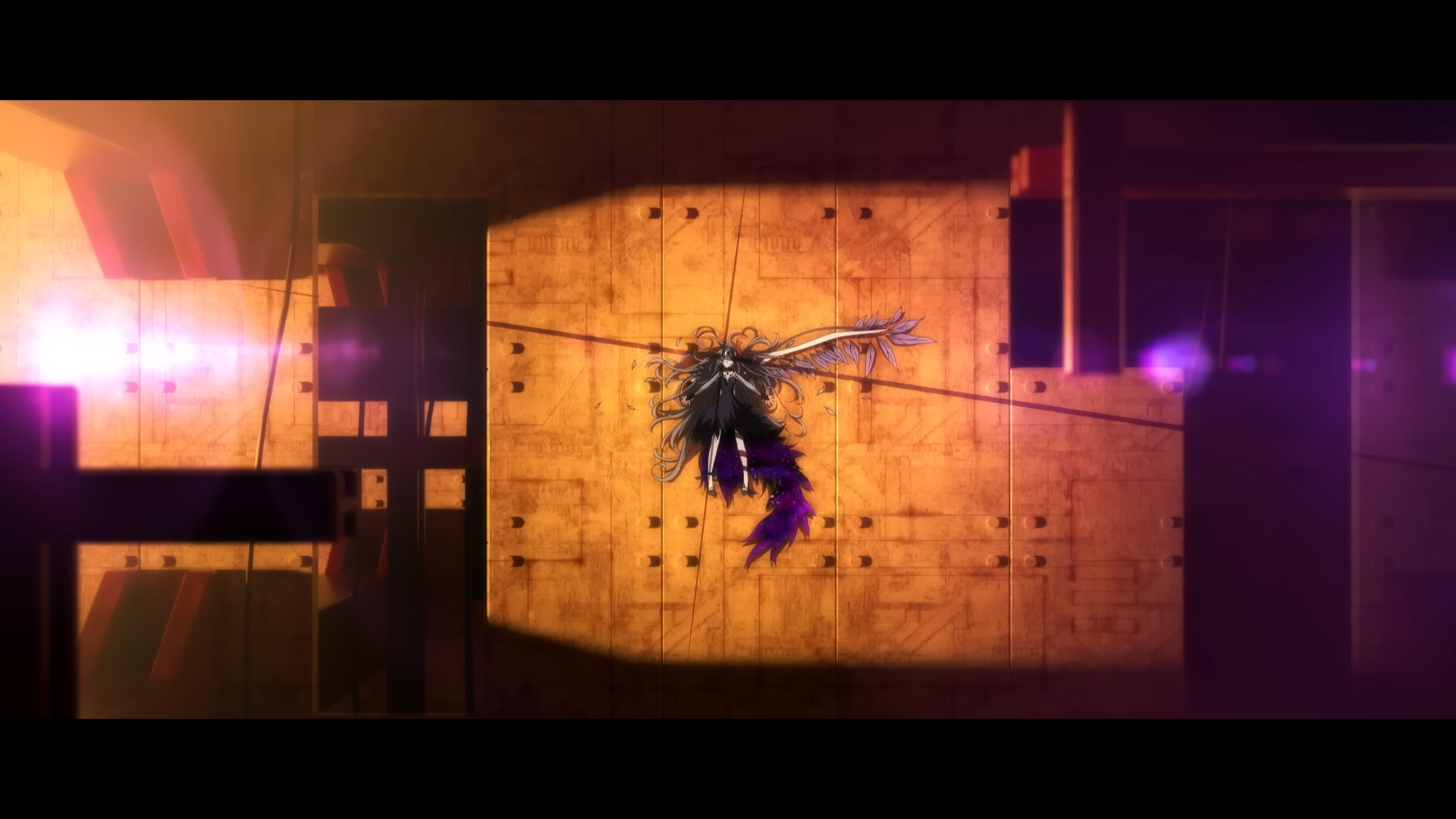
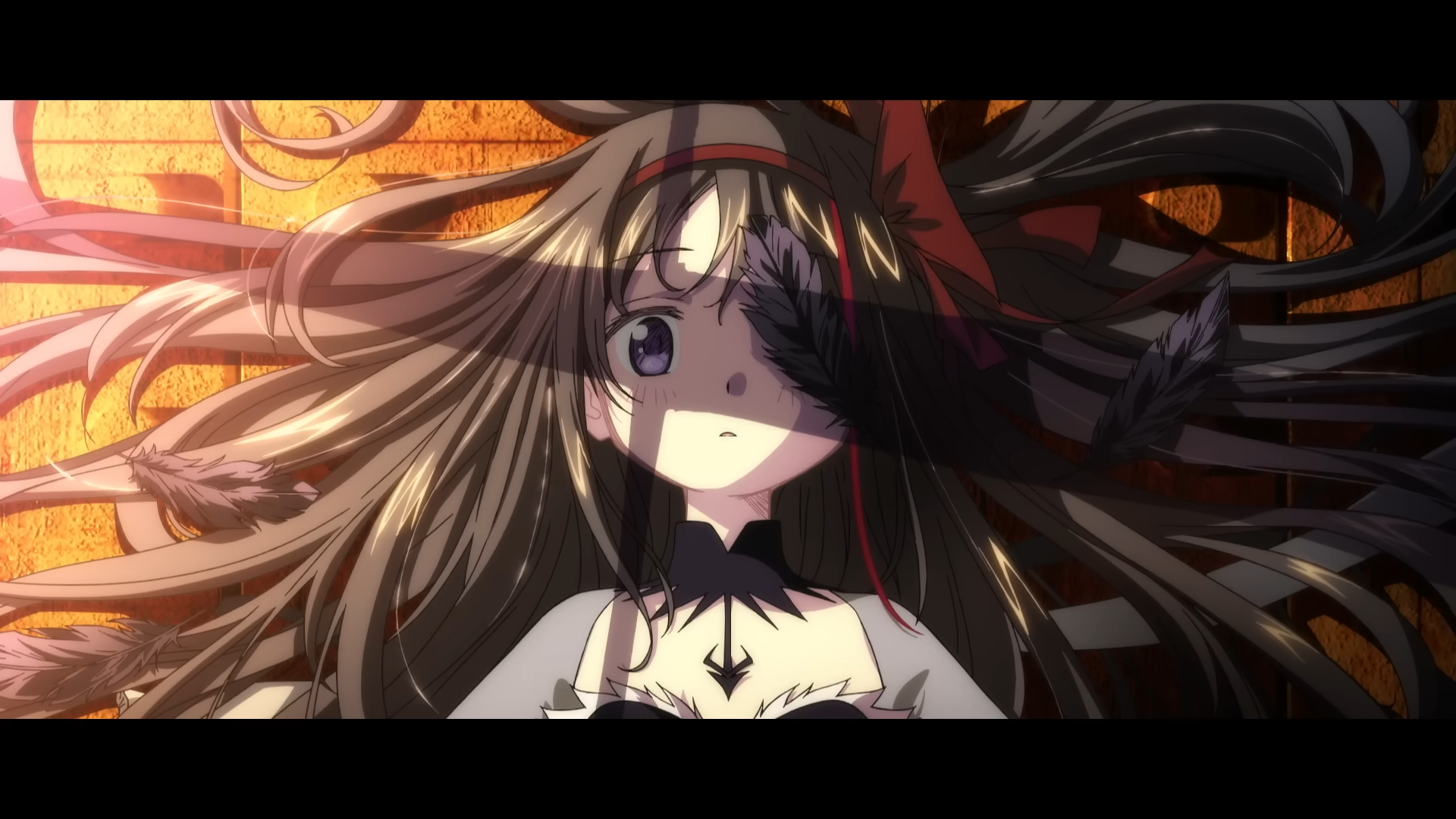

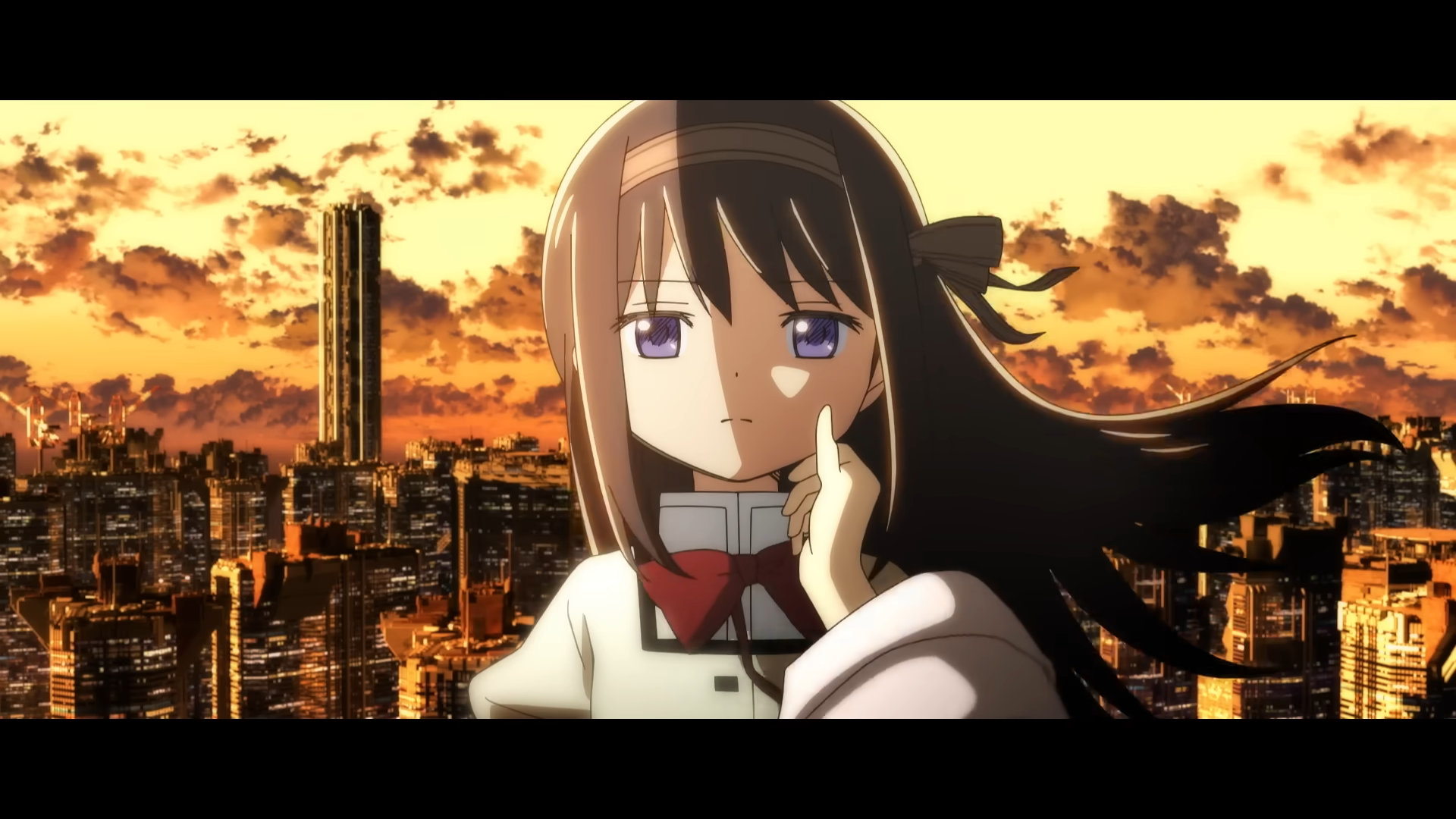
©Magica Quartet/Aniplex, WR
What is Akiyuki Shinbo even doing here?
More Information:
- Misaka, Taiji, ed. (2009). まりあ†ほりっく アニメ公式ガイドブック [Maria Holic Anime Official Guidebook]. Media Factory.
- Magica Quartet (2011). 魔法少女まどか☆マギカ公式ガイドブック you are not alone. [Puella Magi Madoka Magica Official Guidebook you are not alone.]. Houbunsha.
- Oguro, Yuuichirou (May 2, 2011). さよなら絶望先生全書(ANIMESTYLE ARCHIVE) [Sayonara, Zetsubou-Sensei Complete ANIMESTYLE ARCHIVE]. Anime Style.
- Shinbo, Akiyuki (2012). 新房語 [Shinbogatari]. Ichijinsha.
- Kizawa, Yukito, ed. (2013). ひだまりスケッチデイズ -TVアニメ公式ガイドブック- [Hidamari Sketch Days: TV Anime Official Guidebook]. Houbunsha.
- Magica Quartet (2014). 劇場版魔法やまどかマギカ[新編]叛逆の物語公式ガイドブック only you. [Movie Version Puella Magi Madoka Magica [New Edition] Story of Rebellion Official Guidebook only you.]. Houbunsha.
- Oota, Keiji; Shaft (2017). パンフレット 打ち上げ花火、下から見るか?横から見るか? [Pamphlet: Fireworks, Should We See It from the Side or the Bottom?]. Toho.
- Shinbo, Akiyuki. Takahashi, Yumi, ed. (2019). Akiyuki Shimbo x Shaft Chronicle. Dotcom.
- Magica Quartet (2020). マギアレコード 魔法少女まどか☆マギカ外伝 TVアニメ公式ガイドブック 1巻 [Magia Record Puella Magi Madoka Magica TV Anime Official Guidebook Volume 1]. Houbunsha.
- Aniplex (2021). Pretty Boy Detective Club Vol. 5 Special Booklet. Aniplex.
- Magica Quartet (2022). マギアレコード 魔法少女まどか☆マギカ外伝 TVアニメ公式ガイドブック 2巻 [Magia Record Puella Magi Madoka Magica TV Anime Official Guidebook Volume 2]. Houbunsha.
- CUT July 2024 issue (2024). Akiyuki Shinbo Interview. rockin-on.
- Newtype January 2025 issue (2024). Midori Yoshizawa Interview. Gekkan.
